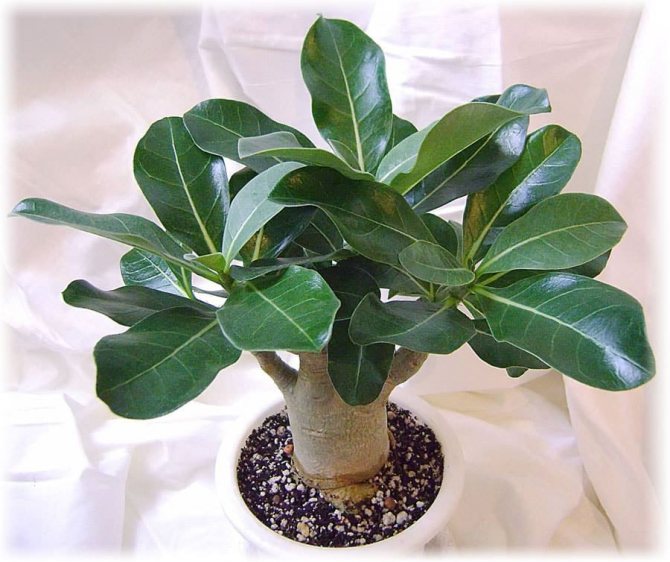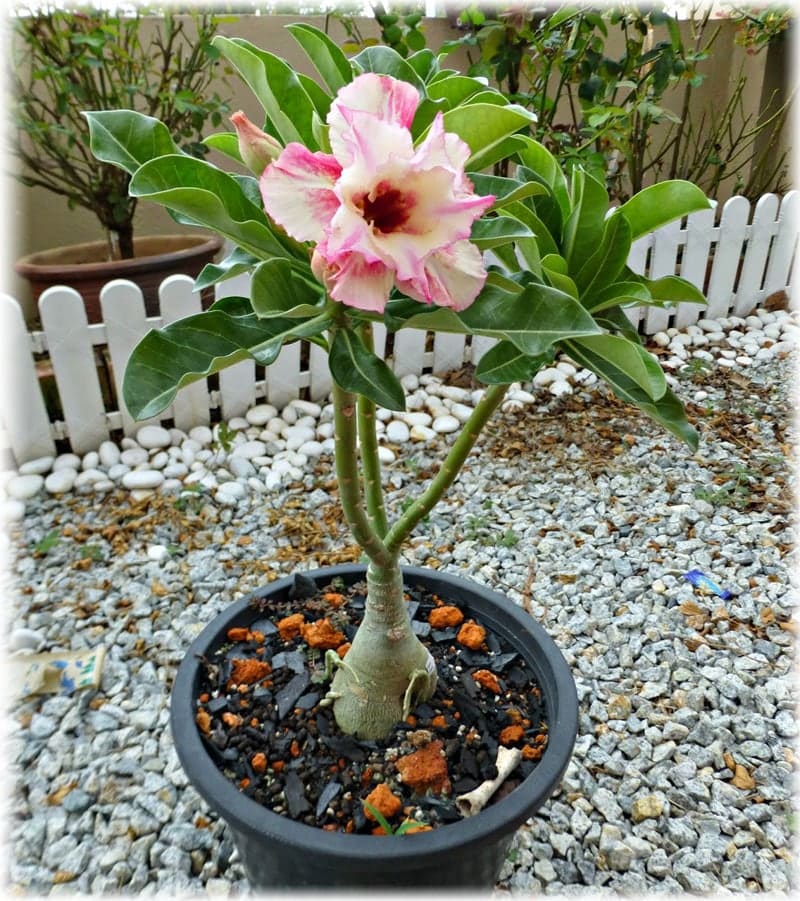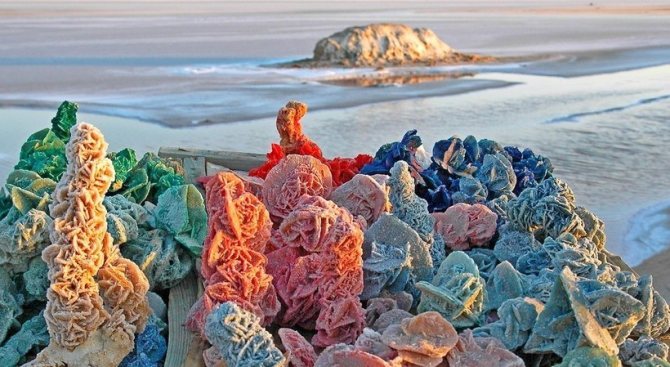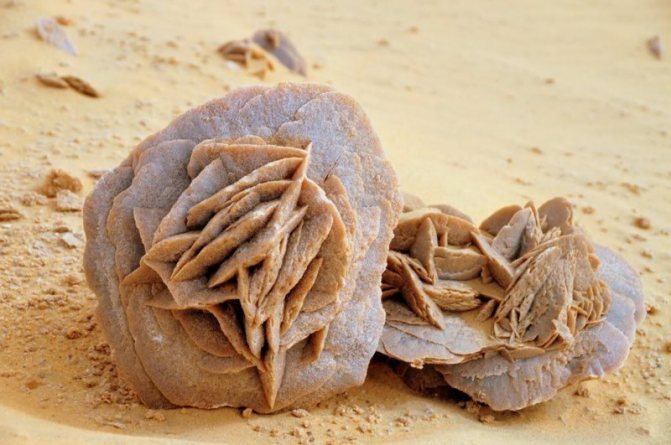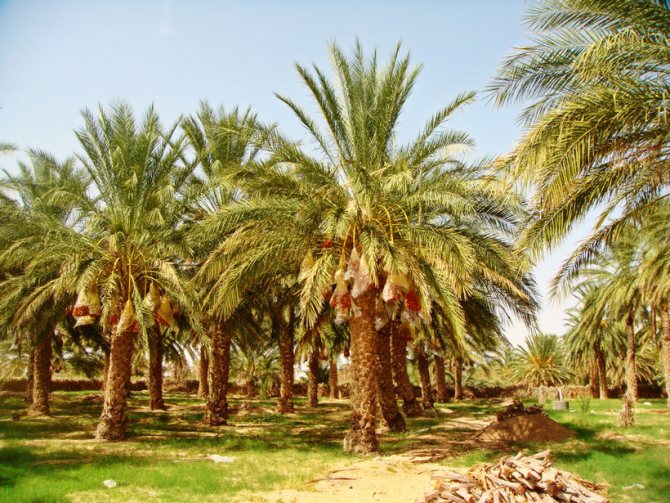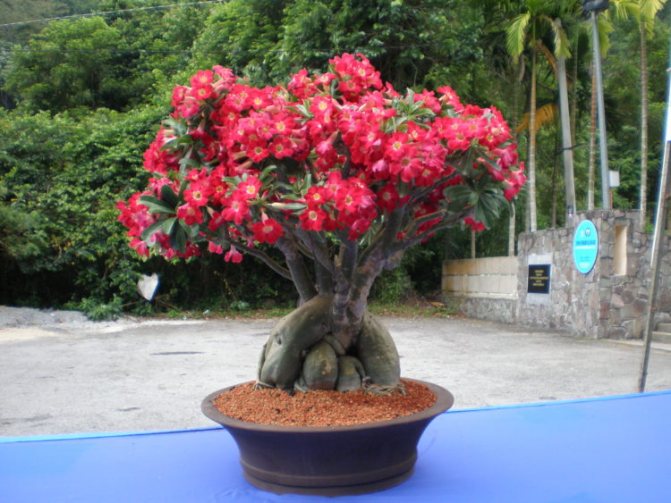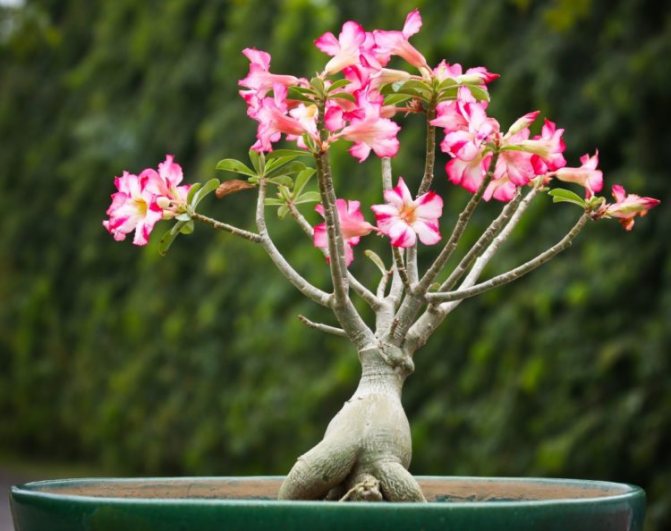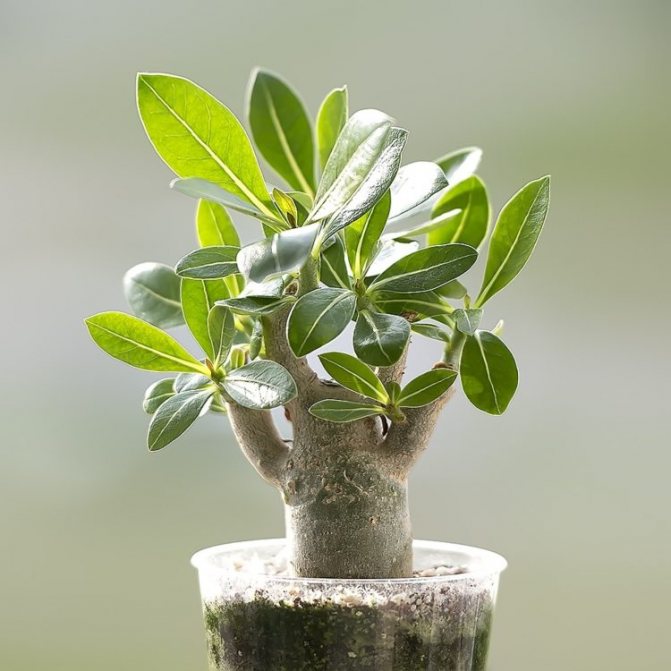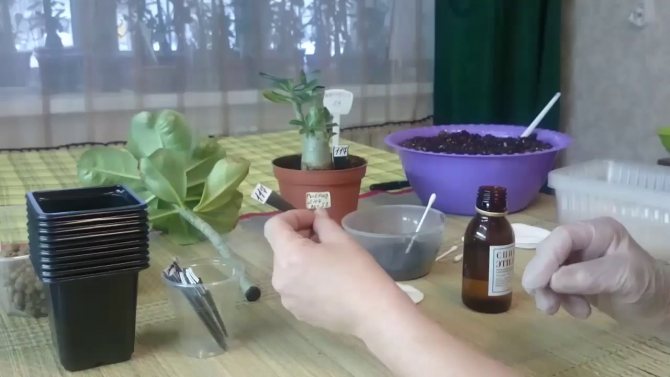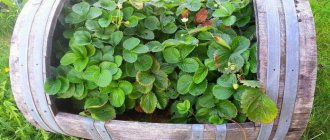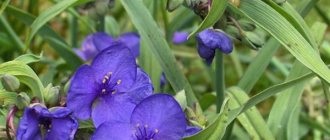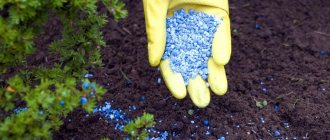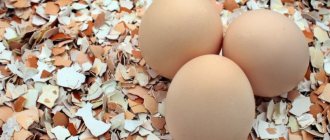The desert rose flower is native to Africa. This plant attracts the attention of gardeners with its unusual appearance and original inflorescence, which is compared to a rose or a lily. For all its exoticism, caring for a desert rose is not difficult at all, and even beginners can cope with the cultivation of this unusual culture.
In today's article, we will look at the features of this African plant, as well as the nuances that should be considered when growing it at home.
Morphology
On adult specimens, the stem, or caudex, becomes swollen, thick, and often bizarre. This gives the adenium an extraordinary and amazing look. The leaves are usually bright green. During the dry season, the desert rose is strewn with vibrant flowers. The size of adenium can reach 5 meters, but there are also such varieties that are enough for a small bowl in an apartment. Currently, a large number of desert rose hybrids have been bred. They are characterized by a wide variety of flower colors - from traditionally red to striped and orange. It is worth noting that adenium is poisonous; children and pets should not come into contact with it. Wash your hands thoroughly with soap and water after handling the plant.
Lighting adenium for home care
Adeniums are light-requiring, unlike most houseplants, they do not need shading and feel best on the south and east side.
In summer, the more sun they get, the more magnificent the bloom will be, the denser and healthier the crown will be. In winter, conditions do not change, but if there is not enough light, then the shadow can be partially compensated by maintaining the temperature within 15 ° C or for a long time.
Striving for the sun, indoor adeniums lean towards the window. You can restore beauty to the crown by turning the flower. Over time, the stem will straighten again.
The light regime for adenium, which comes from the equatorial zone of the planet, should be kept close to natural values. That is, from autumn to spring, in order for the plant to receive light for 12-14 hours, it will need illumination.
Varieties
The desert rose is represented by a huge variety of subspecies. Let's take a look at the most common ones. Adenium swazicum is one of the hardiest desert rose varieties. It is characterized by its small size and adaptability to living in a city apartment.
Adenium arabicum (Adenium arabicum) is used as a garden plant, has a thick and powerful squat trunk. The leaves of the Arabian adenium are fleshy and dense, very similar to the leaves of succulents. Interestingly, the color of caudex is very diverse, it can have purple and pink spots.
Somali adenium (Adenium somalense). This species is characterized by its large size and a powerful, widened base of the trunk. For the first year and a half, it grows very quickly, reaching one and a half meters in height during this time. The ambient temperature when growing Somali adenium should not fall below 12 ° C.
The most popular among florists and desert rose lovers is the Adenium obesum. Other names of the species - Adenium obese, Adenium thick.It is characterized by a great variety of caudex and flower colors. Breeders successfully use this and create more and more new hybrids of Adenium obesum.
How to water adenium?
The watering regime of the decorative African native depends on:
- from the season;
- from air temperature;
- from the container of the pot;
- from the soil chosen for adenium;
- on the location of the plant and the phase of its vegetation.
During the period of active growth, the plant needs a lot of water, and the higher the temperature, the more adenium needs.
In hot weather, the soil in the pot should be slightly damp. This will help keep the flower alive and keep flowers from shedding. It is not necessary to spray adenium.
Cold snap is a sure sign to the grower that watering needs to be reduced. Excess water often causes disease and death of the root system. How to water adenium to be sure of the optimal amount of moisture?
In summer, at a comfortable temperature, a new portion of water is needed when the topsoil is completely dry after the previous watering. In winter, in a cool room, you need to water the flower sparingly, when the substrate is completely dry. In a warm room and while maintaining growth, adenium is watered as usual, but somewhat less often.
Growing conditions
The tropics and subtropics are considered the most favorable areas for growing and breeding adenium. Outside of these belts, the flower requires special care. Constant warmth is the main condition that the desert rose needs. The plant is very demanding for lighting. The apartment is ideally located by a south-facing window. This will ensure that the leaves of the rose are in direct sunlight at all times. Watering the plant should be rare. In winter, reduce water intake, but at the same time, do not overdry the soil, keep it sufficiently moist. The soil for planting a rose should be drainage and slightly acidic. When buying a mixture for your future rose, choose the soil for succulents and cacti. Feed the adenium with fertilizer every summer. In order for a desert rose to grow in a more interesting and bizarre shape, use one secret. Remove the top of the plant's root system from the soil, leaving just over half of them in the soil. Thus, the roots will be slightly open, and as a result of growth, together with the trunk, they will begin to form an interesting shape.
Sultan's Highness Princess Fawzia bint Fuad of Egypt.

0
See all photos in the gallery


0
Fawzia bint Fuad was an amazing child. The black-haired little beauty with blue eyes, Adil Sabit, an Egyptian courtier and writer, described as "an endlessly naive, protected by all, fenced off from all external problems girl-gift" who lived in a "bucolic environment, accompanied by a crowd of respectful servants, aunts and nannies."


0
Studying at school in Switzerland, Fawzia bint Fuad, in addition to her native Arabic, spoke English and French fluently and was brought up in the best traditions of European culture. However, upon returning to Egypt, Fawzia, by virtue of her status as a princess, found herself trapped in the regulations and prohibitions that accompanied the daily life of the royal family. Adil Sabit writes: “In those days, Fawzia was a prisoner in the maternal household ... She rarely went out for walks, and in those few hours when this happened, she was always accompanied by maids of honor and servants. At a time when other young girls enjoyed relative freedom, Fawzia, due to her social status, was constrained in everything. "
Reproduction
Desert rose is a plant that usually propagates by seed. They ripen in pods. Germination can be accelerated by spraying and periodically heating the pot from below.In a week, the first shoots will appear, and in a month, when several true leaves have formed on the seedlings, you can start transplanting. Desert and cuttings, but specimens grown in this manner may not have the thick, vigorous tuberous stems that when grown from seed. Pinch off a shoot 7-10 cm long from the stem and dip it in a solution with fungicides and hormones, for example, in a solution of "Epin". Then plant the cutting in a small pot filled with a slightly moistened 1: 3 mixture of perlite and peat.
Princess Fawzia bint Fuad of Egypt with her former son-in-law Ardeshir Zahedi. 2005 year.


0
Fawzia found all the vicissitudes of the history of modern Egypt: from socialism to oligarchy, then to the dictatorship of Mubarak and again to revolution. In the difficult days of July 2013, when the country watched with excitement how the situation would develop after the removal of Egyptian President Mursi from power by the military, Fawzia bint Fuad Shirin quietly died in Alexandria, having outlived her second husband and daughter Nadia. Princess Fawzia bint Fuad of Egypt and Iran, Mrs. Shirin, died on July 2, 2013 at the age of 92 in Alexandria. The funeral took place the next day in Cairo after midday prayer. The flower of the East, torn apart by the ruthless sands of big politics and turbulent history ...
Transfer
A small pot is enough for a young man. But as the adenium grows, it needs to be transplanted into a more spacious container. This procedure should be carried out only in the warm season. First, make sure the soil is dry, then carefully remove the adenium from the pot. Remove old dead roots and any rot. Treat the cuts formed during transplanting with solutions - fungicidal and antibacterial. Place the rose in a new pot and fill it with soil. Refrain from watering for about a week to prevent root rot, as adenium is very susceptible to this disease. Also, be careful not to damage parts of the plant.
Soil for adenium and its transplant
The soil mixture for adenium should be light, very loose, nutritious and permeable to moisture and oxygen. The acidity level that is comfortable for the plant is pH 5.5–7.
Today, there is a sufficient range of ready-made substrates on the market, based on peat or coconut fiber. For adenium, soil for succulents or universal soil with the addition of loosening, structuring components is suitable.
If the acquired soil is too dense or seems poor, you can mix the soil for adenium yourself by taking:
- 5 parts of the finished substrate;
- 3 parts of leafy soil with a high humus content;
- 2 parts vermiculite, river sand or perlite.
A good addition would be crushed charcoal, which can act as a natural component of the soil or.
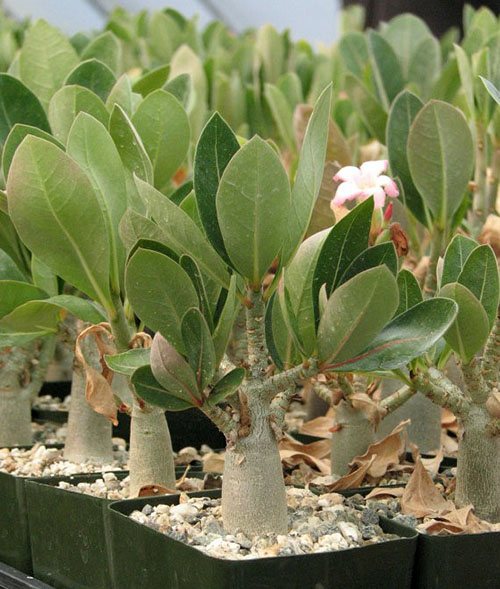

In the recommendations of large manufacturers involved in the cultivation of adeniums, there is an indication of the composition of the substrate for this culture. A part of perlite is added to three parts of the crushed tree bark. Such soil for adenium perfectly permeates air and moisture, never compresses and can be considered universal. However, there are not too many nutrients in it, so the grower will have to think about frequent feeding his pet.
This is also the result of a significant proportion of foam balls, brick chips, charcoal and other disintegrants, which are added to increase the airiness of the substrate.


Adenium transplant is most often carried out in the spring, when active growth begins. The new pot should not be too large, otherwise the plant may postpone the long-awaited flowering. However, even in a too tight container, it is difficult to achieve a harmonious shape of the caudex trunk.
If the reason for transplanting adenium was the formation of its bizarre roots, within 5-7 days such a plant is not watered or moistened very carefully. Healthy adeniums, such as seedlings transferred to individual pots, can be watered as usual.
Desert rose in your garden
If you want to decorate your garden or yard with adenium, try to find the most sunny place for this. A desert rose planted in partial shade has elongated, thin, oblong stems and is more susceptible to disease. The land on the site intended for planting should not be too wet or prone to flooding. If there is no dry soil in your garden, make an embankment at least 20 cm above the main soil. It is also important that the desert rose grows out of the reach of automatic watering and spraying systems. Together with this species, you can plant a variety of heat-loving ones.It is important to know the optimal composition of the soil mixture, which is ideal for planting adenium in open ground. Preparing it yourself will not be difficult.
This mixture includes:
- peat - 2 parts;
- coconut fiber - 2 parts;
- sand - 2 parts;
- perlite - 1 part.
For the first couple of years, the desert rose grows very quickly. At this time, it is important and necessary to supply the soil with organic and mineral nutrients. Later, the growth rate slows down, which is normal. In spring and summer, liquid fertilizer should be applied every two weeks. And during the fall, the intensity of fertilization must be reduced.
Get this wonderful flower in your home. A desert rose can help decorate a room or liven up the look of your garden.
There is a rose of the desert. It is represented by an aggregate with aggregates of lenticular crystals, thus resembling flowers in appearance.
It is formed by absorbing the smallest particles of sand, so its color depends on the color of the sand. The process of formation of a desert rose is quite complex and occurs under certain conditions. When precipitation falls in the desert, water is instantly absorbed into the sand. In the case when the sand contains a large amount of gypsum, the sand particles are washed out, which subsequently go into the depths with the water. In extreme heat, the water rises again to the surface layer, and its complete evaporation leads to the formation of new gypsum crystals. Due to the fact that the desert rose is formed in a layer of sand, it is an integral part of the crystals. Gypsum crystallization occurs in a monoclinic system. Its hardness is very low - 2. Specific gravity - 2.3-2.4. Perfect cleavage is characteristic. The fracture is uneven.
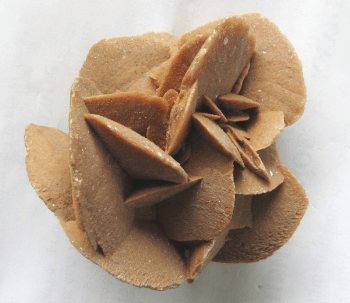

Since ancient times, the inhabitants of the Sahara Desert have known about the existence of this flower. The nomads were the first to notice this miracle of nature. They assumed that the desert rose was formed from camel urine. However, this flower, as it turned out later, appeared from plaster. Rose petals, which are strikingly beautiful, have a diameter of about 2-3 millimeters. Desert rose crystals are found in places where the climate is hot and sandy soils rich in gypsum.
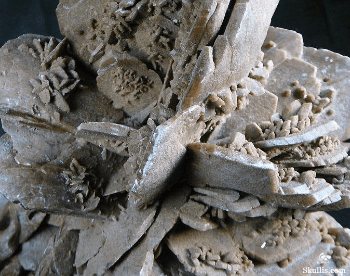

A wonderful natural creation - the desert rose is of high value for collectors. Despite the fact that this unique natural creation is in great demand, the Algerian government has put a ban on its exports. The desert rose is a symbol of most of the arid regions of the planet.
It is not yet so widely known, but a representative of the kutrov family is quite attractive and unusual - the Adenium flower, also known as a desert rose. The genus Adenium includes almost 5 thousand species, among which there are small shrubs and trees.
The desert rose has a thick trunk, large flowers of various colors and velvety fleshy leaves. The flowers grow up to 6 cm in size and grow in clusters on the tops of the branches.Adenium has a powerful root system, which tends to grow strongly.
Under natural conditions, it can reach up to 3 meters in height, cultivated grows only up to 35 cm. The plant is native to South Africa, belongs to succulent. Domesticated varieties are whimsical and demanding on conditions of detention.
Adenium got its popular name from the rose-like flowers. The sap of the plant is poisonous, so you need to be careful when working with the flower.
In order to keep adenium in a home flower garden, to see its beautiful delicate flowers and succulent spectacular leaves, you need to take good care of the flower and create the required conditions for it.
The magical and healing properties of the stone
The desert rose is considered a stone that is able to deliver its owner from one of the deadly sins - pride.
It is believed that this stone is magically capable of creating a situation in which a person prone to arrogance will find himself in any hopeless situation. They say that, in this way, he shows a person how dangerous a too high self-esteem can be and how ridiculous it is.
And in some countries, the "desert rose" is presented to each other on Valentine's Day. This is a special gift, as many believe that this stone symbolizes unfading, strong love. Residents of several African countries follow a certain tradition.
According to their beliefs, for a girl who wants to get married, you need to find and give a rose of the desert. Then she will soon find her happiness.
And on the wedding day, the bride's parents give her such a stone precisely because it symbolizes strong love, family hearth and a happy life with her husband full of joy and prosperity, and also maintains warm family relations for many years.
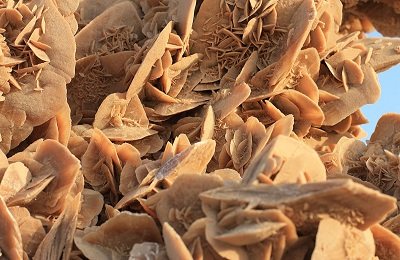

It is believed that the desert rose stone, like many others, has special healing properties. Promotes rapid healing of broken bones. It is not for nothing that gypsum is so widely used in the medical field to fix damaged limbs. With such a disease as tuberculosis of the spine, a plaster bed is made for the patient, which will also contribute to a speedy recovery.
Powder prepared from gypsum will help cope with hyperhidrosis, that is, with increased sweating of the legs or arms.
Also, gypsum is actively used in cosmetology. From a mixture of plaster powder, oil and water, a gruel is obtained, which is later used as a mask for toning the skin of the face.
This gypsum mineral is recommended for those who are too hot-tempered. Such individuals need something that will restrain their ardor and protect them from unnecessary conflicts and quarrels. Desert rose stone will help maintain inner balance, calmness and harmony of too hot-tempered people. These are usually those born under the sign of Capricorn, Leo, Sagittarius or Aries.
It is not yet so widely known, but a representative of the kutrov family is quite attractive and unusual - the Adenium flower, also known as a desert rose. The genus Adenium includes almost 5 thousand species, among which there are small shrubs and trees.
The desert rose has a thick trunk, large flowers of various colors and velvety fleshy leaves. The flowers grow up to 6 cm in size and grow in clusters on the tops of the branches. Adenium has a powerful root system, which tends to grow strongly.
Under natural conditions, it can reach up to 3 meters in height, cultivated grows only up to 35 cm. The plant is native to South Africa, belongs to succulent. Domesticated varieties are whimsical and demanding on conditions of detention.
Adenium got its popular name from the rose-like flowers. The sap of the plant is poisonous, so you need to be careful when working with the flower.
In order to keep adenium in a home flower garden, to see its beautiful delicate flowers and succulent spectacular leaves, you need to take good care of the flower and create the required conditions for it.
Desert rose care rules
The territory of origin of this flower has a special climate, which has shaped the needs of adenium, which must be satisfied in order for the flower to delight its owners with its feed and flowering.
Choosing a place for a flower
Adenium is a light-loving plant, and therefore the best place in an apartment for it would be a room with windows facing south, west or east. When summer comes, it is better to put a flower pot on a balcony or loggia.
Lighting
Adenium is one of the few plants that loves when the sun's rays hit directly on it. The more sun there is, the better for this succulent. When the illumination becomes worse, which usually happens with the onset of winter, then watering is immediately reduced.
Temperature conditions
The homeland of the succulent is distinguished by a hot climate, therefore, they love the high temperature in the room where they are kept. The most favorable temperature range in summer is from +25 degrees to 30 degrees, and in winter from 12 to 15 degrees.
When the temperature drops below this value, the plant slows down its growth and sheds its leaves. When the temperature rises above 30 degrees, stagnation is also observed, that is, growth stops. In winter, with a decrease in temperature, watering is also reduced, otherwise the roots of the plant will begin to rot.
Watering mode
In the hot season, watering is needed moderate, next time it is watered only after the earthen coma dries. In winter, watered with a minimum amount of water and are guided by the state of the plant.
The main rule of watering adenium, when the illumination or temperature decreases, watering is also reduced.
If watering is reduced, while the lighting and temperature are left unchanged, then the rose will stop developing, and in the worst case, it will dry out. The humidity of the air does not matter much, and there is no need to spray the flower.
Plant transplant
Indoor pets are transplanted as needed in spring or summer. Young succulents need to be replanted every year, adult specimens every 2-4 years. The rose tolerates transplanting well, but it is not worth picking up a large pot right away for it.
Otherwise, the root system will begin to grow strongly and this will affect the vegetation of the ground parts. A large pot needs to be watered more abundantly, and water unused by the roots will stagnate and cause rotting of the root system.
When a young specimen is actively growing, it is better to pick up a little larger pots and replant it every three months. As the plant grows older, it will not grow as vigorously and will not need to be repotted so frequently.
For the transplant to go well, you need to water the plant a few days before. When transplanting, you should not destroy the earthen lump, and use the transshipment method. This method allows you not to injure the root system and the plant will quickly take root in a new pot and grow. Adenium is placed in a new pot with a lump and soil is poured around.
Soil requirements
Adenium loves light, humus-rich soil that has a neutral pH value. Various rippers are added to the prepared soil for cacti, which help to increase the aeration of the soil. As such ingredients, you can take perlite, sand, expanded clay fine fractions or charcoal.
Plant formation
Form the crown by pruning and pinching the shoots. In order for the plant to branch well and to give it a cultivated look, it is necessary to remove the branches in full or in part in a timely manner. Pinching is the process of removing short sections up to 2 cm of the apical and lateral shoots.
This is the same as pruning, the only difference is in the length of the branches to be cut. The plant is pruned in the spring, four weeks after transplanting.You cannot prune the plant when it is dormant. Water the plant two days before pinching. Cut off the shoot slightly above the dormant bud.
Top dressing
You need to feed adenium every three weeks. Fertilizers designed for cacti or universal complex fertilizers are suitable as top dressing. Top dressing is best done more often, but in small doses.
Overfeeding the plant causes vigorous growth of all parts, but they grow weak and thin. Such a plant often loses its decorative appearance and, more often than others, suffers from rot.
Organic fertilizers work well for desert roses. You can add chicken manure or horse manure. These fertilizers are dug into the topsoil. If during the period when it is necessary to apply top dressing the plant is sick or has undergone a transplant, then the top dressing is temporarily canceled. In winter, the plant is also not fed, as it hibernates.
What roses look like in the desert
not alive. They are not just growing, but rather forming.
It takes a lot of time for such a formation, and this process takes place not throughout the entire desert, but in some places.
It is customary to call the area where the main localization of roses in the desert is concentrated, the Valley of Flowers.
The materials that make up roses are crystals. They, in turn, are composed of salt, sand and water.
Gradually accumulating, moisture enters the surface of the salt, and the winds bring sand.
Bulk materials adhere to a damp surface, which are formed due to the movement of air and natural accumulation processes.
When the desert rose is already formed, it can be found at a depth of about a meter in the sands.
These natural materials are dug up and decorate the streets of African settlements, brought to other cities, where you can sell and make money.
Roses of the Sahara are a great gift option for local people.
The desert stone rose is odorless, it does not have a velvety surface, but it does not fade either.
This is an ordinary stone that forms in the shape of a flower, which is why it is called that.
Why is this stone called the rose of the desert?
Despite the fact that such a “plant” is not alive, it can bloom. All thanks to the unique properties of sultafs contained in the stone.
In this case, a stone flower blooms after it hits an open surface, in contact with air and wind.
The color of desert roses is beige, even rather flesh-colored. But the petals have a sharp shape - coarse salt can scratch the skin.
By the way, the colors of roses in different deserts do not always coincide.
There can be many shades of flesh and beige, and in some regions it is quite possible to find even black roses, white and some others.
However, black flowers are, rather, a highlight of the Argentine deserts, but white is possible.
Pests and diseases of adenium
Like most houseplants, these are. This pest sucks out the juice and enmeshes them in cobwebs. Pests live in large colonies and multiply rapidly. The mite quickly depletes the plant and eventually dries up and dies.
The first sign of the appearance of a tick is light dots on the leaves. In adenium, they are fleshy and dark, so the bite marks of these insects will be immediately noticeable. It is best to deal with it with insecticides.
Adenium gets sick very rarely, plant diseases are most often associated with improper care. Mainly on roots and leaves rot develops
... The reason for its appearance is waterlogging of the soil in the pot.
Then you need to dry the soil a little, and remove the rotten parts. if the soil is heavily flooded, then it is better to transplant the plant. A sharp drop in temperature, drafts, combined with dampness, cause the development of putrefactive bacteria that affect leaves and roots.
In fact, keeping and caring for a desert rose does not require any special skills.Subject to the recommendations, even a beginner can grow this beautiful tree. Taking proper care and taking care of the desert rose, in return it will give many beautiful flowers and decorate the flower garden with dignity, becoming the pride of the owner.
How to care for adenium at home: growing and reproduction How to properly care for a Chinese rose at home: growing and reproduction How to care for a room rose in a pot at home: proper watering and growing Adenium obese - care
The stone is a compound of gypsum crystals, which is composed of water, sand and salts. Desert rose can look different. These stones can vary in size, petal length, and color. You can find crystals with petal lengths from 3 mm to 20-30 cm.
Desert roses are mostly beige in color, but black or white stones can be found in some regions.
The petals are quite tough due to the high amount of salt. You need to be careful with them, otherwise you can get hurt.
Magic stone
People love to surround everything beautiful and unusual with legends and mysticism, so the desert rose was endowed with magical properties. The Bedouins who drove caravans of goods across the Sahara have long drawn attention to the unusual education. They believed that the stone was formed as a result of camel urine falling on the sand. Perhaps, in some ways they are right - urine is also liquid, and falls into the same mass of sand heated by the sun. There is also a belief that a desert rose is formed as a result of a lightning strike in the sand.
For its durability in comparison with a living rose, the stone is considered a symbol of unfading love, and is given as a souvenir to beloved ones.
In the countries of North Africa, the desert rose symbolizes true love and family happiness. Young girls are given a stone so that they get married as soon as possible. At the wedding, her parents present the young with a desert rose so that the family hearth never fades away, so that the spouses live a long and happy life.
Occultists attribute to the desert rose the ability to rid the wearer of pride. And there really is a rational grain in this - all earthly riches and glory are very fragile and short-lived, they can be destroyed in an instant from the slightest influence from the outside, just like this fragile stone. And one should not be very proud of one's riches and achievements, there is no need to rely on them unnecessarily.
Getting to a person, the desert rose constantly reminds that the value system should be revised. And he puts especially slow-witted proud people in situations in which overestimated self-esteem decreases to a normal level.
The desert rose strengthens people who are not self-confident in their good intentions, makes them calmer, relieves suspiciousness and a tendency to depression.
Helps the stone and overly impulsive and quick-tempered people. Therefore, it must be in the form of an amulet or decoration for representatives of fire signs - Aries, Sagittarius, Leo, as well as Capricorns. The desert rose will help them become more judicious and restrained.
The stone is a compound of gypsum crystals, which is composed of water, sand and salts. Desert rose can look different. These stones can vary in size, petal length, and color. You can find crystals with petal lengths from 3 mm to 20-30 cm.
Desert roses are mostly beige in color, but black or white stones can be found in some regions.
The petals are quite tough due to the high amount of salt. You need to be careful with them, otherwise you can get hurt.
The peculiarity of the formation and deposit of stone
Not all areas with sand can form this mineral. This stone is shaped in a very interesting way. The formation of this mineral occurs in sand with a high content of gypsum.
After precipitation falls, moisture is absorbed into the soil.With a high content of gypsum in the soil, it goes into the depths along with the incoming water. Then, under the influence of high air temperatures, all the liquid evaporates. When this process is completed, crystalline gypsum formations of an unusual, twisted shape remain in the sand.
Since the stone is formed in the sand, it becomes an integral part of it. As a result, a very beautiful mineral is formed, which resembles a rose in shape, since its plates are slightly curved and twisted.
This gypsum rose even tends to bloom a little, almost like a real plant.
This amazing process takes place only on the surface, when the stone can interact with the wind and fresh air. The desert rose has this ability due to the special properties of the sulfates contained in the mineral. This stone is a fairly popular gift among residents of those regions where it can be found most often.
The main deposits of this stone are the USA, Mexico, Australia, Germany, Egypt, Slovakia. A desert rose is mined in the sand, at a depth of about one meter. Depending on the place of extraction, the color of the stone can vary greatly. For example, in the deserts of Argentina, you can often find black stones. But the desert rose in Tunisia has a predominantly white tint.
Gypsum is the most abundant mineral in the world. That is why the cost of a desert rose on various sites or in any stores is quite low. Stones that weigh from 30 to 50 g can be seen for 250-300 rubles. If desired, you can easily afford the purchase of such a mineral.
How does she do it?
A desert rose can not form in every desert, and not from every material. Nature uses special sand for her creations - with a high content of gypsum. The technological process developed by her is as follows: first it rains, and the sand is wetted with water. The gypsum in the sand is washed out and, together with the water, tends downward, deep into the surface, which is heated under the hot rays of the sun. We all remember the stories of travelers that chicken eggs in the desert can be baked right in the sand without using heating devices.
So, a well-calcined layer of sand shares its temperature with water, and pushes it up, after which it simply evaporates. Particles of gypsum again keep the water company, and rise upward with it. Gypsum, moistened with water, is known to set very quickly, in this case it hardens, turning into crystals of a unique lenticular shape, which are very similar to a rose with thin petals.
Thus, the Desert Rose stone is an intergrowth of gypsum crystals. But the shape and size of the intergrowths are not always "floral", they can be very diverse. They are given a certain shape during processing.
The gypsum in this creation is not entirely pure, it contains sand and other impurities that slightly change its color. Desert rose is capable of forming not only in the Sahara, gypsum flowers are found in other regions of the planet, for example, in the deserts of North America, Australia, Argentina. The samples found there have different colors and shades. Most often, their color is determined by the sand that is in this area, they are light or dark beige, less often white or black samples are found. Sometimes sellers paint them to give the desired color.
Note that not only sand determines the structure of the stone, it also contains mineral salts, so it is durable, and the petals are so hard and sharp that you can cut your fingers on them.
The diameter of the petals is different - from a few millimeters to 2-3 decimeters, the number of petals in the joint is also different. Roses with a large number of petals are especially appreciated. Overall, though, they are not overly expensive.Pebbles weighing up to 50 grams are sold at a price of 200-300 rubles. Larger and more attractive samples are not much more expensive.
Local residents of North African countries sell attractive-looking stones to tourists. accompanying the trade in local tales and legends. The number of tourists is constantly growing, and roses are not found as often as we would like. Therefore, the authorities of some countries, for example - Algeria, have issued a law prohibiting the export of desert roses outside the country.
Some of them end up in private collections, while the most beautiful ones are used to make jewelry. Gypsum is a rather fragile material, such jewelry must be very protected from everything - shock, falls, temperature changes, and so on.
The origin of the plant
The natural habitat of adenium is African countries, especially in the central and southern regions. It is a succulent. Plant characteristics:
- A thick trunk, it is called caudex, reaching a meter in girth in natural conditions.
- The height can be up to two meters. When breeding a house, its dimensions are miniature, about 70 cm in height.
- It blooms profusely with five-petalled large flowers, the size of which reaches 60–70 mm. Variety of colors from white to red to dark purple.
- Flowering time is 3 weeks a year.
Adenium literally translates as a desert rose, this plant has other equally beautiful names, for example, the Star of Sabinia, Impala Lily.
However, it should be noted that the flower is actually very poisonous. Therefore, when transplanting, you need to use rubber gloves, and if the juice gets on the skin, rinse with plenty of warm water. You should not buy adenium if there are small children and animals in the house.
The desert rose was discovered to the world as a new plant in 1891 during a research mission in former South Yemen by botanists J. Romer and J. Schultz.
How to prepare for wintering?
In winter, you need to be especially careful in caring for adenium... Since this plant needs about 13-14 hours of daylight hours, and in winter it is very difficult to do this, they resort to stagnation of the flower. Stagnation is the slowing down of all processes in a plant.
For this, the conditions of detention are changed:
- lower the temperature;
- humidity and increase the intervals between watering.
Acceptable temperature of the content of adenium in the spring is +11 .. + 12 degrees. If it is above +15, then it will be necessary to stop watering for a sufficiently long period of time to enter into stagnation. The minimum temperature should not fall below +5 degrees. If you keep adenium in a negative environment, the plant may die..
Dry the soil a lot between waterings. The frequency of watering will depend on the temperature and will be 7-20 days. Sometimes they practice keeping a flower with just one watering for the whole winter.
In winter, humidity should be low. Top dressing in the cold season is not carried out. The first time when it will be necessary to feed is the exit of the adenium from the state of stagnation.
Origin and botanical description
The adenium flower belongs to the Kutrov family. There are shrubby and arboreal succulents that grow in nature in the corpses of the Arabian Peninsula and Africa. Its discovery was made near the city of Aden.
The description and characteristics of this flower are unusual. The plant is poisonous, its sap was used by the aborigines for the purpose of impregnating arrows. The stems are light gray, strongly branched and have a bottle-shaped base at the base. Leaves are medium-sized, with pointed or rounded ends, glossy and fleshy.
The succulent plant begins to bloom in mid-spring and stops flowering closer to mid-autumn. Some varieties are characterized by an abundance of flowers in winter, but those gardeners who do not follow the rules for caring for a plant can only see this beauty in pictures.The color of the buds is varied: purple, pink, yellow, scarlet, white and red-black.
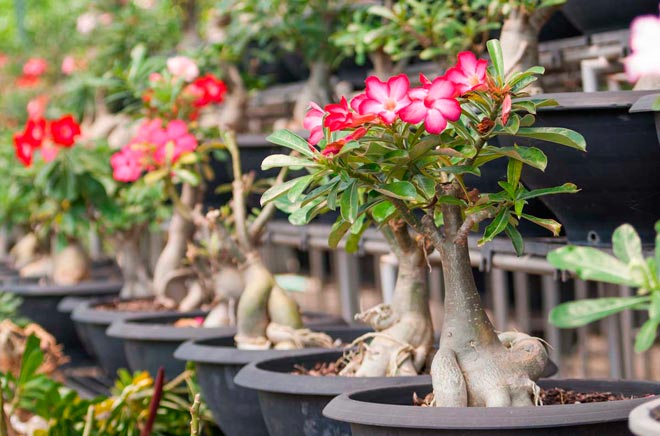

We increase decorativeness
The value of adenium as a pet also lies in the fact that its owner can independently form an individual, different from other plants, appearance of a flower.
Pruning the central shoot
Not everyone is happy to grow a long green "hose" into which adenium will certainly turn without pruning. Its apical kidney is the most powerful. She pulls all the forces of the plant onto herself, and the lateral shoots risk never waking up.
Pruning is done to stimulate their development. The desired result is the uniform formation of several side branches instead of one central one.
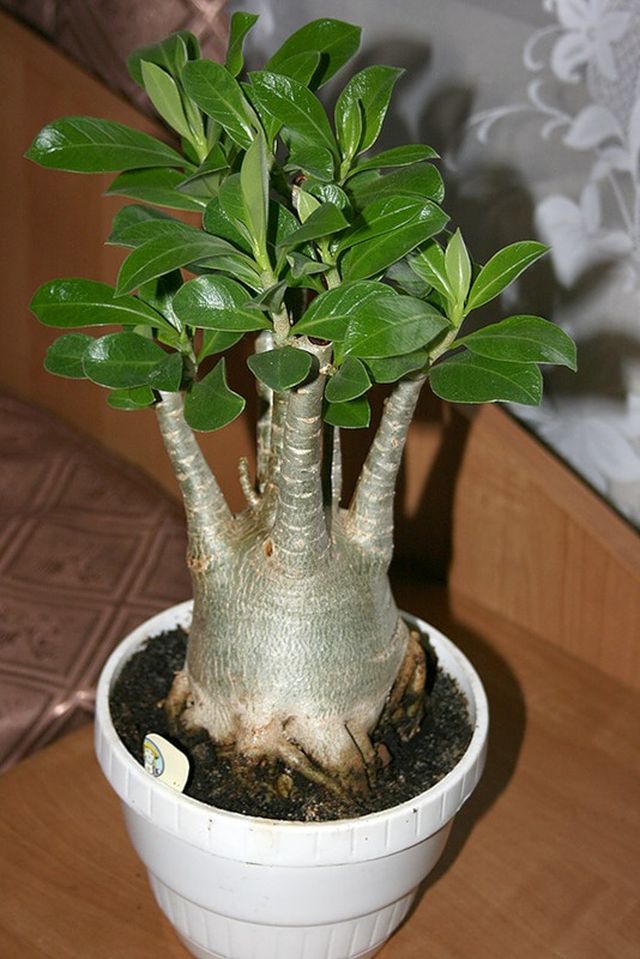

Pruning the central shoot contributes to the harmonious development of several lateral branches of adenium at once
Pruning of the main shoot of adenium is done a few weeks after the spring transplant. Before the procedure, the flower should grow a fairly thick caudex (at 12-18 months). Then, predicting the appearance of future new branches, you can adjust the appearance.
Experienced growers warn against pruning the central shoot too low: then the lateral branches will develop weak.
Pruning is done with a sharp knife (blade) in the spring, with the beginning of active growth of adenium. The cut site can be sprinkled with ash or crushed activated carbon. After 40-50 days, the plant will give new branches from the axillary buds.
A pruning option is pinching: when about 2 cm is still left from the shoot.
Video: transplant and pruning of adenium
Wake up sleeping kidneys
It is possible to wake up the dormant axillary buds of adenium not only by pruning the central shoot. What if the procedure has already been carried out, and you want to further stimulate branching? Or along with and side? Or does the plant need to be rescued? In this case, a cytokinin paste is used.
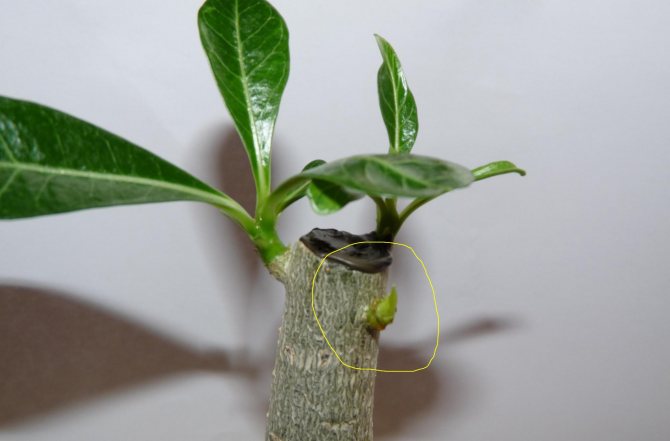

The result of using cytokinin paste for the development of axillary kidneys of adenium
At the end of the match, a small portion of the drug is applied to the kidney, which they want to "wake up". Will she wake up? There is no absolute guarantee. Such stimulation accelerates the development of the kidneys, which were already ready to bloom, but for some reason were delayed in development. Perhaps the cytokinin paste will never have any effect on some of them. However, with the help of treatment with the drug, in some cases it is possible to radically change the appearance of adenium for the better.
Should the taproot be pinched?
The adenium taproot is pinched at an early age, usually during the first transplant. This is done so that during the growth process it does not reach the bottom of the pot. If this happens, the plant may, resting against it, noticeably lean to one side.
Without a taproot, the plant develops an extensive fibrous root system and grows well in low, flat pots.
Pinching is done 0.5-1 cm below the lateral roots. Without a taproot, they begin to develop vigorously and get fat. At the next transplant, they can be beautifully intertwined, and the plant itself can be raised in a pot. Saline stains on the caudex with such a transplant are washed off with plain water using an old toothbrush.
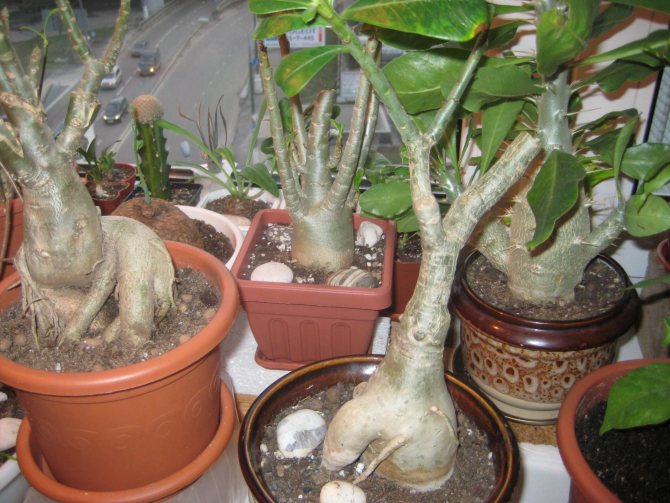

Intertwined and raised lateral roots ensure the uniqueness of the adenium
Video: the formation of the root system of a plant
Bloom
It is great if the grown adenium pleases with flowers without additional efforts on your part. However, sometimes the plant needs a little help.
One of the earliest flowering of adenium on a windowsill in the middle lane was recorded in a 4-month-old plant. But usually in adenium this happens at 2-3 years of age.
Thai flower growers advise: adenium with caudex with a diameter of 18 cm or more can be made to bloom by arranging a "cold period" for two weeks after spring pruning and fertilization. After that, it is necessary for three days to gradually water the flower with fertilizer for orchids, diluted according to the instructions. And repeat the cold period. Several alternations of such stages for three weeks - and the buds will appear. After that, watering must be made complete.


Adenium bloom rewards all efforts to grow it
The main rule of watering and spraying adenium at this time: water should not get on the petals. If this happens regularly, the flowers will rot.
Description of the plant
Adenium (from Latin Adenium) natively growing in the wild, a plant of the genus succulents. These are shrubs or trees of low height, which are native to the tropics of Africa. The weather in these areas of the mainland is very changeable, drought often occurs. This is affected by the approaching Sahara Desert. So adeniums have to somehow adapt to such weather conditions, accumulating moisture in their barrel-shaped trunks. They are called the Rose of the Desert for a reason, because from some languages the name "Adenium" is literally translated this way. Attention! The flower is poisonous. It is recommended to use rubber gloves during transplanting, pruning, etc. Not recommended for keeping in rooms with small children, as well as pets. In case of contact with skin, rinse under running warm water. In addition to their unusual appearance like a "bottle", these indoor plants attract amateur flower growers with flowers, the size of which, as a rule, is 50-70 millimeters in diameter. They are five-petal buds; the color is more often of this type: at the edges of each of the petals the color is slightly darker, and towards the center of the petal and, in general, the flower, it is lighter. In the center of the bud there are both a pistil and a stamen, but pollination inside the flower is extremely rare, and even if set, there are not many seeds in the pods. Flowers on the branches form inflorescences, which is very good in terms of interior decoration.
Magical properties
Desert Rose is considered a highly moral mineral:
- She is able to save the owner from irascibility, arrogance. The stone "insidiously" creates a problematic situation for the owner. A person finds himself in a dangerous or ridiculous position, which prompts him to reconsider his self-esteem, the system of values. The mineral reminds: wealth, position in society are fragile.
- The "desert rose" will support good, but insecure people, relieve them of suspiciousness.
- This is a symbol of eternal strong love, therefore it is considered a gift with special meaning for Valentine's Day. The inhabitants of Africa have a belief that the stone attracts the soul mate. It is given to young ladies who dream of marriage. Better yet, for the girl to find him herself. If it comes to the wedding, the bride's parents give the young people a stone: the family hearth will be strong, life will be happy.


The reputation of the stone of fidelity made the "desert rose" a welcome gift for Valentine's Day among Europeans.
- The magical properties of specimens of the yellow scale are used as a channel of communication with the souls of deceased relatives.
- In African countries, the stone is considered a home amulet from witches and sorcerers.
Astrologers have found that the "desert rose" is suitable for Capricorns, Leo, Sagittarius, Aries. Each of them is impulsive, often not in control of words and deeds. The pebble will keep from quarrels or conflicts. At the same time, it will help to look at the world philosophically.


Lighting.
Since adenium is a desert plant, it must be provided with the sunniest place. Indeed, in natural conditions, they are located under the scorching sun from early morning until evening. Indeed, in rooms such conditions are not achievable even with south-facing windows, especially in winter. On windows of other orientations, I do not recommend growing this plant, because, in this case, the shoots stretch out, and the plant loses its decorative effect.
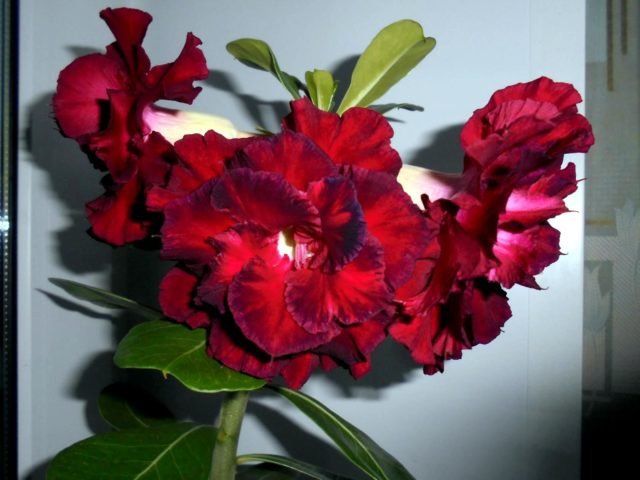

Desert rose flower: how to care
Despite the fact that the succulent adenium in the natural environment grows in rather harsh conditions, which does not prevent it from growing up to two meters and actively blooming, certain care rules should be observed when growing at home.
Only after creating an environment suitable for the flower can a long and abundant flowering be achieved, because it is the bright unusual inflorescences that are the main decoration of the desert rose.
Location selection and lighting
Desert rose is an unusual houseplant, if only because it normally tolerates direct sunlight. Therefore, the flower pot can be placed on the southern or eastern windowsill, and the plant does not need to be shaded (Figure 2).
The more sun and heat adenium receives, the more abundant and bright its bloom will be. In winter, the plant begins a dormant period, although at this time it also needs bright lighting. For this, the culture is supplemented with special lamps. The duration of daylight hours throughout the year should be 12-14 hours. Only in this case can the normal development of tropical culture be achieved.


Figure 2. Desert rose needs bright light, so it is placed on the southern windowsill
Separately, one should dwell on the selection of land for sowing adenium seeds or planting its sprouts. The quality of plant development and the intensity of its flowering will depend on this, as well as on the light regime.
The soil for adenium should be light, as loose and nutritious as possible. In this case, the soil should freely pass air and moisture to the roots. Experts advise choosing a land based on peat and coconut fiber, since such land resembles the natural growing environment of the plant as much as possible. Charcoal is laid out on the bottom of the pot as drainage, which at the same time will play the role of a kind of recharge.
Temperature and watering schedule
Since the adenium flower is native to tropical Africa, at home you need to try to recreate the natural environment of its growth.
When grown at home in the summer indoors, you need to maintain an indicator of + 25 + 30 degrees. With the arrival of spring and steady heat, you can generally take the pot with the plant outside, but you need to take care of protecting it from rain.


Figure 3. Adenium is a succulent, so there is no point in watering it too much
But maintaining a high temperature constantly does not make sense. Any plant, including adenium, grows normally and blooms profusely only if it has a full dormant period. To do this, in winter, the temperature is reduced to + 12 + 15 degrees, and the length of daylight hours is reduced by several hours.
Timely watering also plays an important role in the successful cultivation of a desert rose (Figure 3). It is carried out after the soil around the root and in the pot is, in principle, completely dry. Too often watering adenium does not make sense, since the plant normally tolerates a lack of moisture, and its excess can negatively affect the condition of the flower. In winter, when the culture enters the phase of vegetative dormancy, watering is completely rare and scarce. In the summer, you can periodically spray the plant from a spray bottle, but it is important to make sure that the liquid does not get on the flowers, otherwise they will fade.
Top dressing of adenium and choice of fertilizer
Since at home, adult adenium bushes grow indoors, its care should include periodic feeding. It is enough to fertilize the plant at home once a month, and the procedure is carried out only during the active growing season, namely in summer, spring and autumn.
It is better to feed adenium with special complex mineral fertilizers for indoor flowers. It is important to ensure that the concentration of the solution does not exceed 2%, since a more saturated liquid can provoke burns to the leaves and roots. If this still happened, you need to pinch the flower, removing the damaged parts (Figure 4).
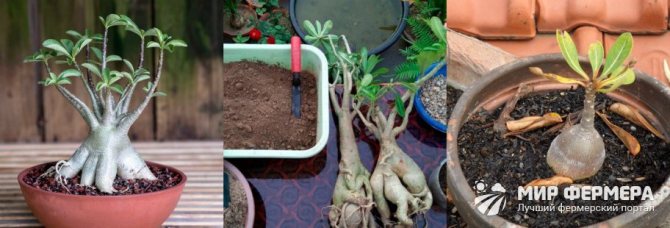

Figure 4. Complex mineral fertilizers are used to feed the flower
In winter, when the plant is in the vegetative dormancy stage, feeding is completely stopped, since an excess of nutrients can negatively affect flowering in the next season.
Desert Rose Flower Transplant and Pruning
For the correct formation of adenium, you need to regularly transplant and prune the bush. Young plants are moved to new pots annually. The procedure is carried out in the spring, when the plant has not yet fully awakened after a dormant period and will undergo manipulation without stress.
Note: Experts advise you to be careful when choosing a pot. It is advisable to use a light container in which the roots of the desert rose will not overheat. Usually, wide and not very deep pots are taken for adenium. In such containers, the plant does not build up the root system too much and spends all its energy on abundant flowering.
There are no special requirements for how adenium should be transplanted. The main thing is not to damage the delicate roots of the culture when moving to a new container. In addition, in order for the plant to take root, after transplanting it is started to be watered only after 4-6 days (Figure 5).
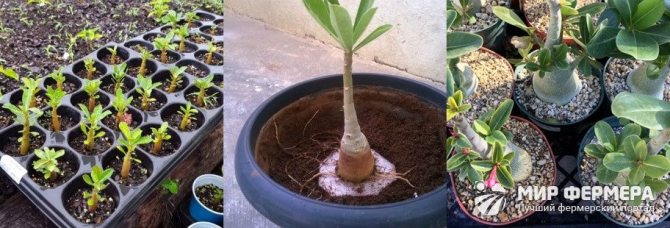

Figure 5. Transplantation of young plants is carried out annually in spring
As for pruning, it is carried out only if necessary and exclusively in the spring. With this procedure, you can form a crown of the desired shape. For example, if you want a desert rose to have the shape of a tree, its side shoots should be shortened by a third. You should also be prepared for the fact that adenium grows very slowly at home, so the formation of its crown will take a long time.
Popular varieties with photos
Adenium is not the name of a particular plant. It is a genus that unites several species. The most famous is considered obese, or obesum. It is followed by other popular varieties with simple, double and smooth flowers, with pointed or wavy edges on the petals, a trunk that is different in shape, but always strong and pronounced.
Obese (Obesum)
Fat adenium reaches a height of 1.5-2 meters. It has a gray-brown trunk that resembles a bottle, with many short branches at the top. It has glossy, deep green leaves that grow up to 10 centimeters, with light veins. The flowers are white or pink in size 6 cm.
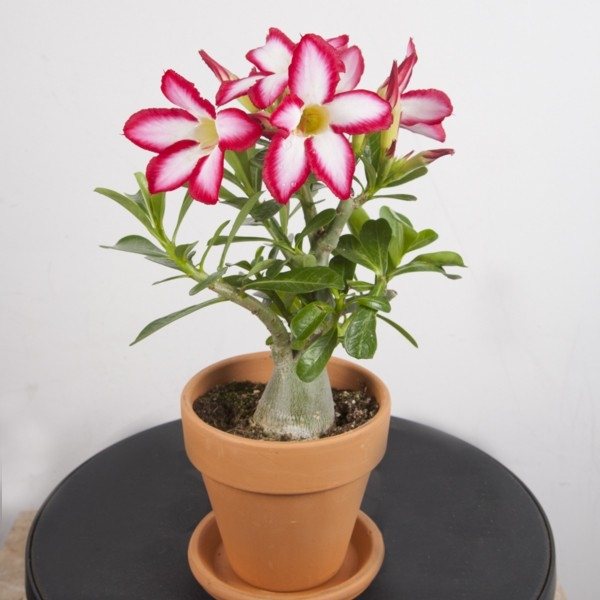

Arabic (Arabikum)
This species has a thick trunk and a branched crown that forms on its own and does not need pruning or pinching. At a height of one and a half meters, adenium has an impressive caudex with a diameter of 30-40 cm. During flowering, the crown of the tree is strewn with small white-pink flowers.


Krispum Somali
It is an elongated tree or shrub with long branches. Its distinctive feature is its narrow leaves. The plant blooms in pink flowers with sharp curved petals. Much of the caudex is underground.
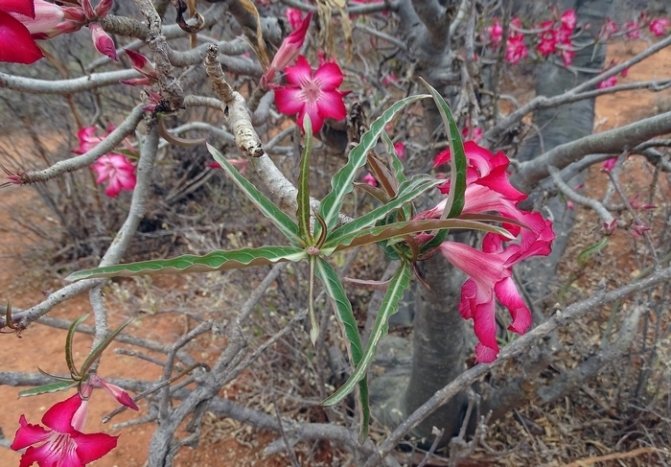

Swazicum
It is a slow growing species. Its height is no more than 50 cm. It has oblong narrow leaves, flowers 5 cm in size are deep pink in color. The flower is difficult to adapt to home conditions: the tips of the leaves often dry out, after which the shrub stops growing.
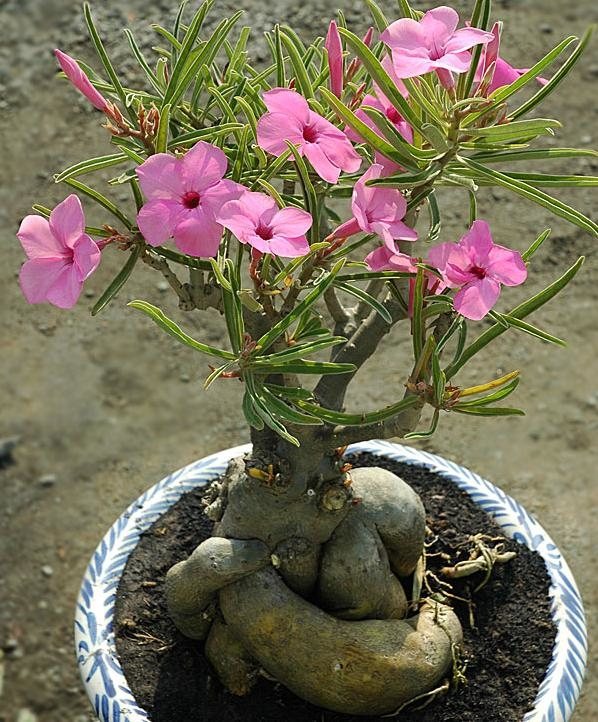

Multiflorum multiflorum
Abundantly flowering species. The dense crown is covered with small flowers with bright pink edging on the petals. The trunk is strong, massive, intertwined.
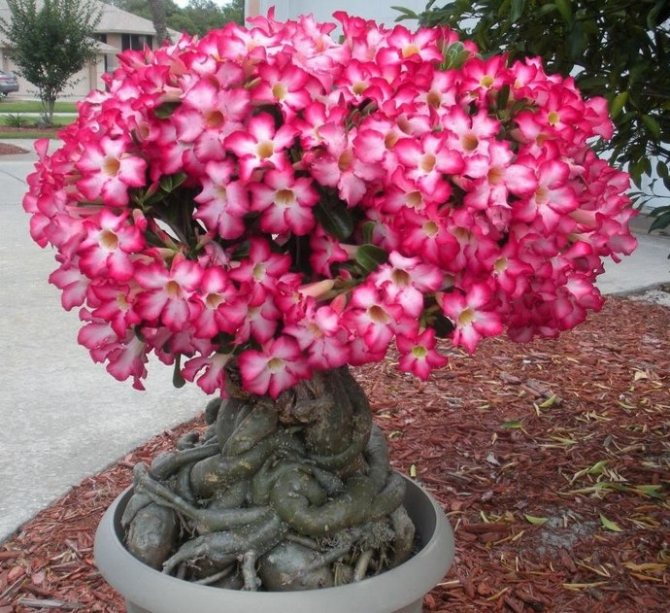

Boehmiaum
The plant with the largest flowers (7-8 cm in diameter). Most often they are white or red. The leaves are also large, velvety to the touch. The caudex is implicit.


Socotran (Somalense)
This species is very moody. The plant is distinguished by thick caudex, undeveloped thin branches, oblong leaves and small flowers. It grows very slowly and rarely pleases with flowering.
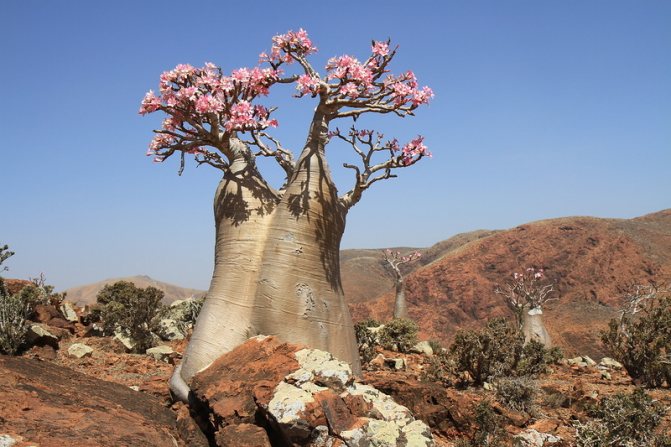

Oleifolium mini
This is a dwarf shrub. Caudex is hidden underground. Elongated olive-colored leaves. Flowers are pale pink or peach shade with rounded, wavy petals.


Double Color
The plant stands out with flowers in black and red tones. The tree begins to bloom with red flowers, but after a few days the petals turn black.
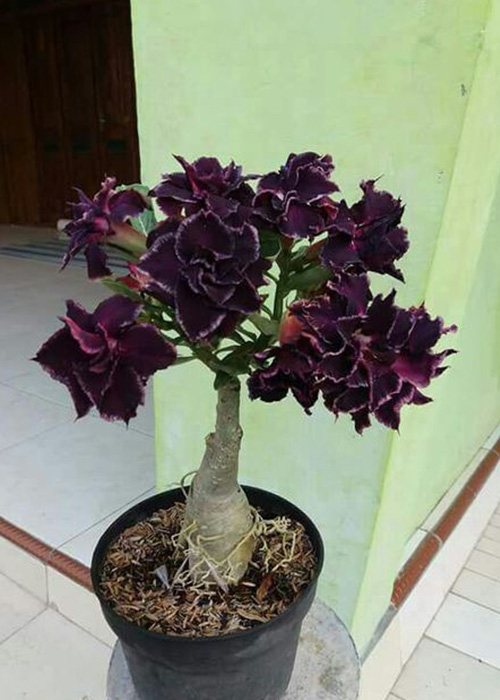

Pearl Rose (White Pearl)
A tree with large lush white flowers and small olive leaves.
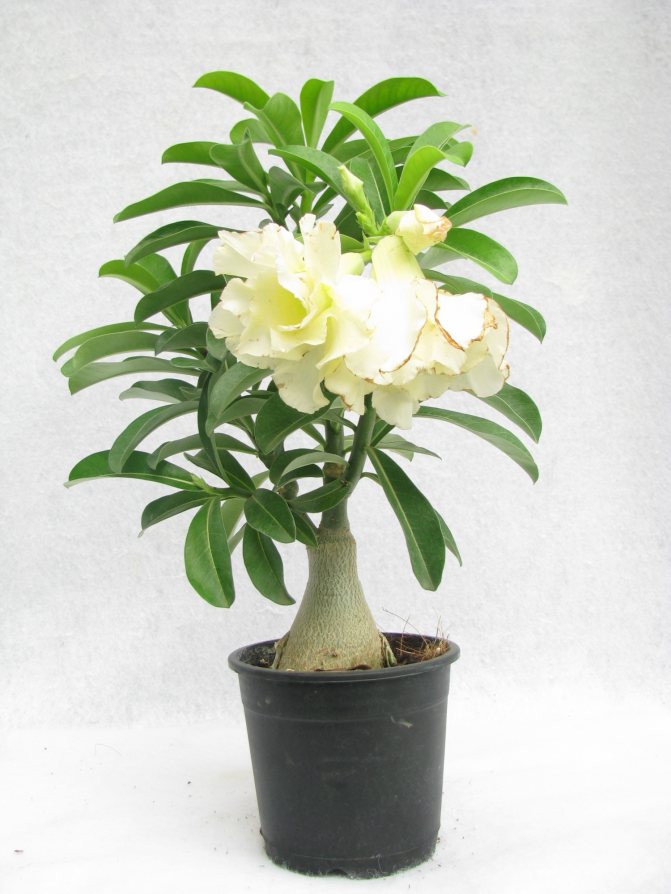

Blue Spirit
Adenium with a bottle stem and long, thin branches, on which grow flowers of a pale blue shade with a pink core.
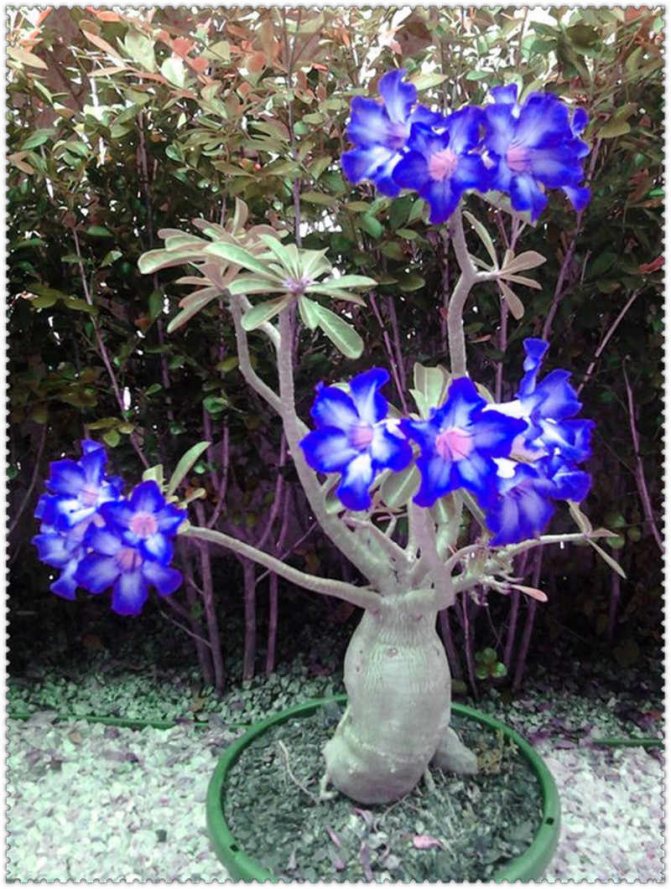

Silk of Yellow
The tree has a bottle trunk, large shiny leaves and double flowers of white-yellow or bright yellow color with red veins.
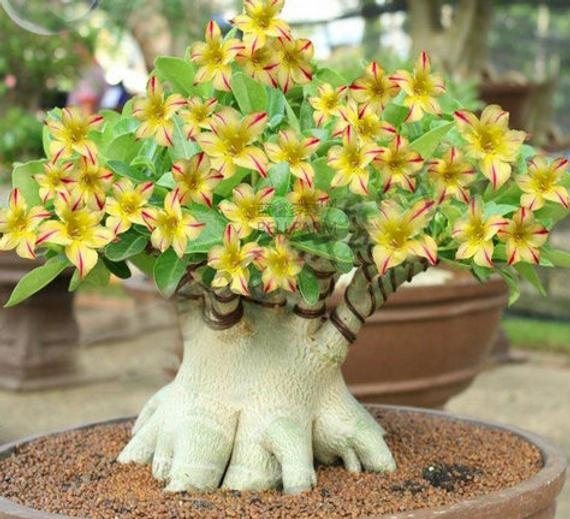

Formation of adenium caudex


Adenium is a rare plant that allows the grower to form not only the aboveground, but also the underground part. Pruning and shaping the adenium caudex allows the grower to grow incredible specimens.
The flower is extremely "loyal" to all the manipulations of a person who can intertwine the roots, cut off some of them or completely remove the bottom of the plant in order to grow a new root system of a given shape.
Most often, on the basis of adenium, bonsai are formed like a mangrove tree. For this:
- choose a grown seedling with a thick stem base;
- at the plant at the site of the caudex narrowing, the root is cut off;
- the resulting cutting is rooted again in water or a loose mixture of perlite and vermiculite.


When the plant regains roots, it is transferred to a wide pot, on a light soil for adenium. A previously prepared round plate of dense plastic is placed under the handle. The roots are straightened and fixed to give the desired shape. Then the roots are sprinkled with soil one or two centimeters.
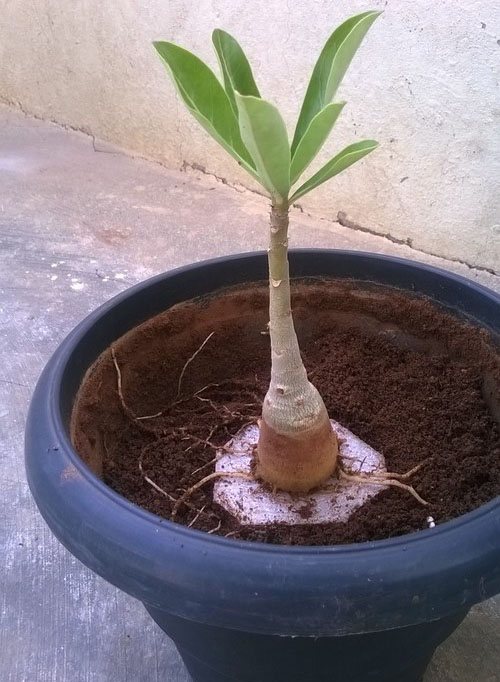

Care after such a formation of adenium caudex consists in more frequent, usually moderate watering and regular checking of the position of the roots. To do this, the plant is transplanted twice a year, straightening the rhizomes and removing unnecessary ones.
Plant varieties
Depending on the type and variety of ademium, the size of the plants differs significantly. The most common are the following varieties:
- Santa Claus. The variety is distinguished by its extraordinary beauty during the flowering period. The flower petals are milky red in color and bordered by a white stripe. Flowering is noted for six months. The view is displayed by sectioning.
- Oleander. A natural variety that continues to be improved through the efforts of breeders. There are two subspecies of this variety: monochromatic and mix. The flowers are white and crimson.
- Dorset Horn... The variety is rare and very unusual. The shape of the leaves as a result of the mutation became similar to the horns of a sheep. The rest of the characteristics are the same as for other varieties. In many ways, flowers are similar to mini-size adenium. Their colors are white and crimson.
- Fat... Grown at home. A year after planting, the plant will bloom. Branches in the lower part are thickened, but taper towards the top.
- Anaconda... Visually looks like a tree. The color of the flowers is red, pink and white.
- Terry adenium (yellow love). The grown succulent blooms in yellow, which is a rarity for this plant. The decorative effect is achieved due to the fact that all the petals are terry, and not smooth.
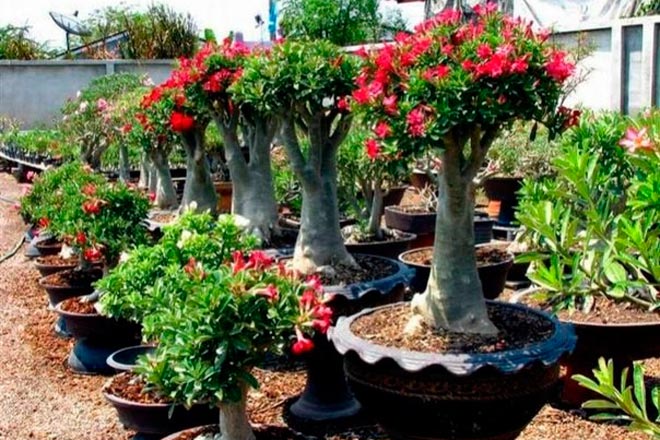

Anaconda
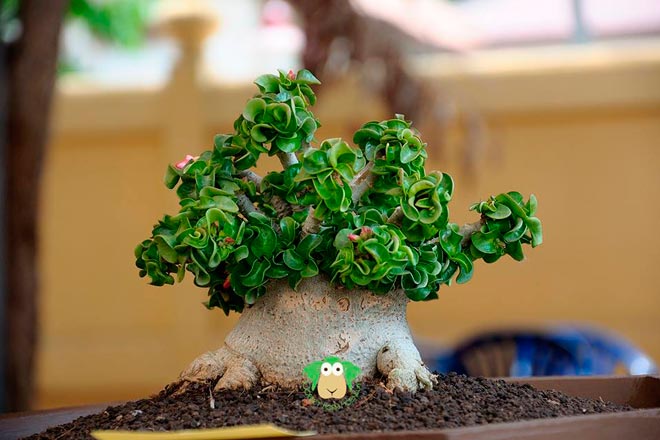

Dorset Horn
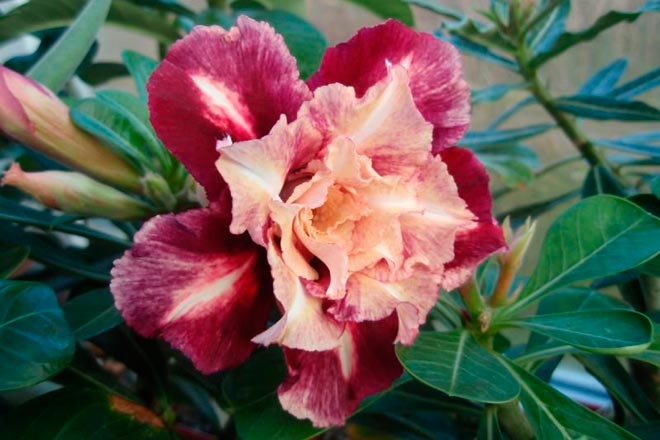

Terry
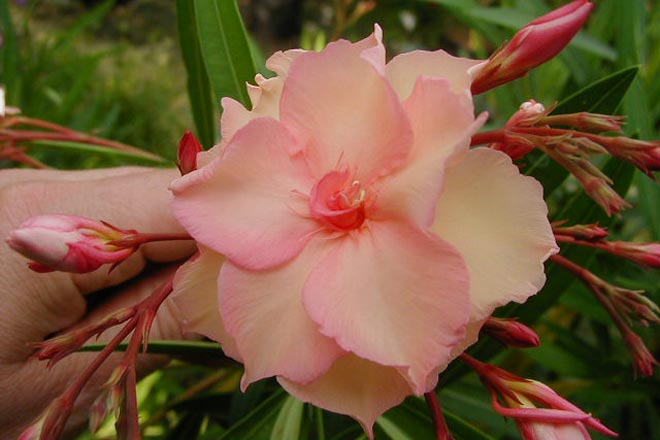

Oleander
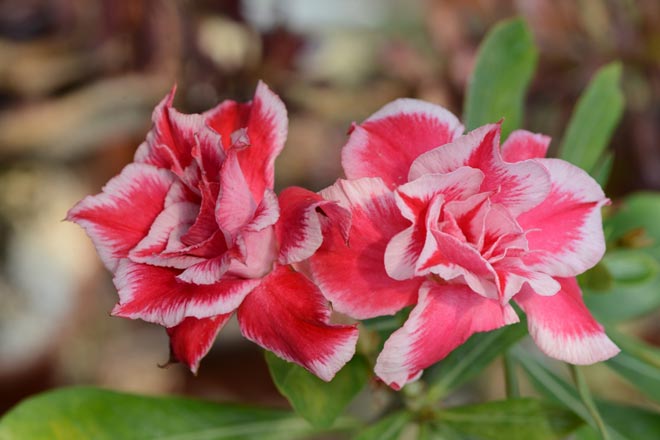

Santa Claus
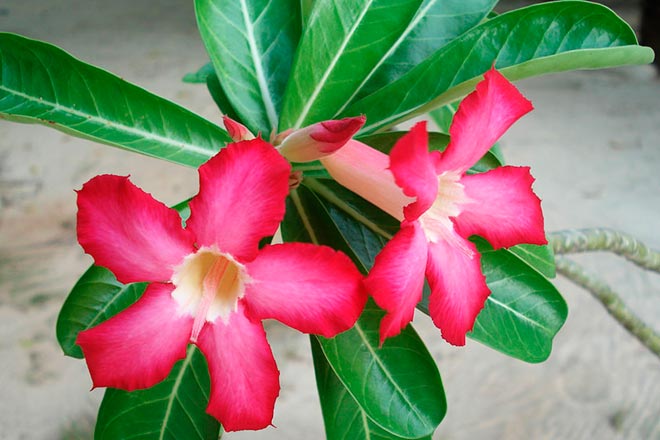

Fat
Reproduction: seeds or cuttings?
Each breeding method has its own advantages. When germinating seeds, you have the opportunity to trace all the phases of development of this most interesting plant. Such adeniums usually form a beautiful, voluminous caudex. If you decide to root the cuttings, then be prepared for the fact that they will not develop a noticeable trunk in the first years.But all the properties of the mother plant, in particular the shade of the petals and the size of the flowers, will be fully reproduced (which, unfortunately, cannot be said about all adenium grown from seeds).
How to prepare and root cuttings of adenium?
Adeniums are cut both in the warm season and in winter. In the second case, additional lighting is required.
- Cuttings for propagation are separated from the plant with a very sharp knife (preferably with a blade);
- The juice that appears on the cut is soaked with a napkin.
- Planting material is dried from 20 minutes (young cuttings) to 2 days (mature and thick).
- The lower leaves are removed.
The cutting can be rooted both in water and in a mixture of perlite and vermiculite (in a ratio of 7: 3). Experts who have tried both methods in practice note the insignificant advantage of the second: fewer failures.
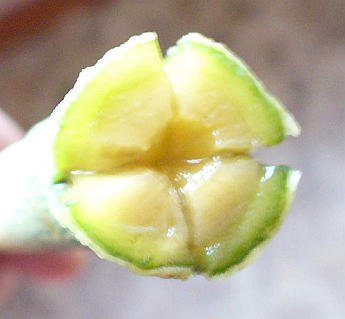

The cruciform incision helps the root stimulator penetrate deeper into the tissues
Rooters for spilling the substrate can not be used: many experimenters note the ineffectiveness, and sometimes even harm, of the use of biostimulants. However, there are also opposite opinions.
In the substrate, the cutting will develop a root system only if the ratio of temperature and humidity is favorable. The moisture-retaining properties of perlite and vermiculite will prevent water from stagnating and the substrate from drying out. Both scanty and excessively abundant watering are equally harmful. The soil should always be slightly moist, but just slightly. If the temperature does not drop below 25-30 ° C, there is every chance of success. The roots may appear in two weeks.
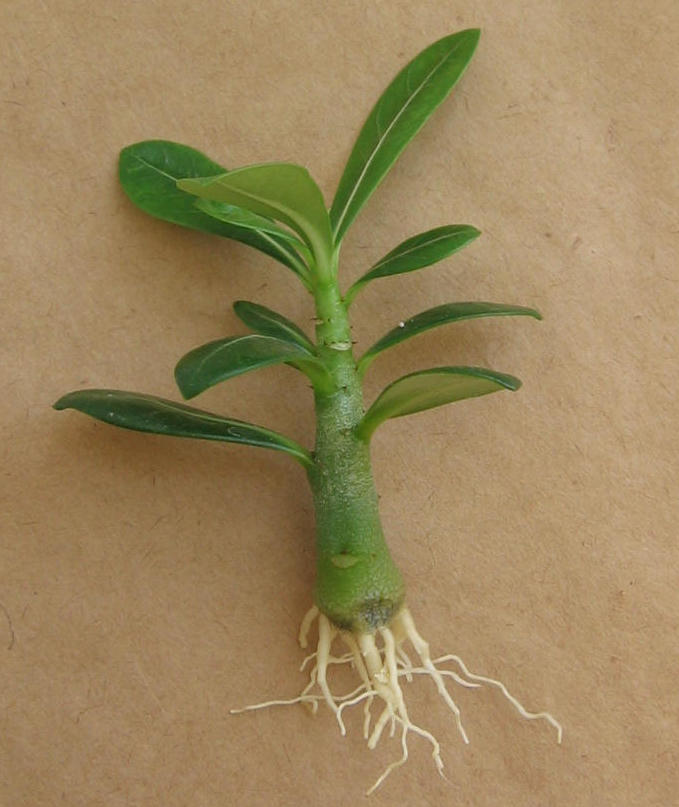

Adenium cuttings develop a root system both in water and in a special perlite-vermiculite substrate
Table: rooting cuttings of adenium: step by step instructions
| Rooting in water | Rooting in a mixture of perlite and vermiculite |
| 1. A shallow cruciform incision is made in the lower part of the cutting. | 1. Cuttings are planted in a prepared moist substrate with bottom heating. |
| 2. Add 1 drop of rooting stimulant per 200 ml of water to the water. | 2. Cover the container with a glass or plastic "cap". |
| 3. Cuttings are dipped in water. Its temperature is kept at the level of 25-30 ° C. | 3. The substrate is moistened as needed. |
| 4. The greenhouse is regularly ventilated. |
Germinating seeds
You can also order seeds on the Internet in winter: they are frost-resistant.
There is an opinion that the germination of the obtained seeds directly depends on their freshness. The sooner the seeds were planted after harvesting, the more harmoniously they will sprout. However, as practice shows, it is almost always possible to reproduce adenium in this way, if you do not make gross mistakes.
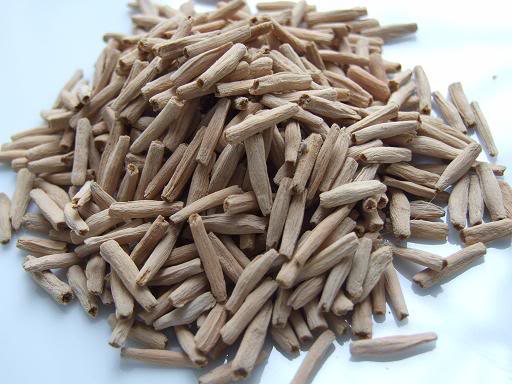

There will definitely not be any difficulties with the acquisition of adenium seeds.
Here is one of the germination options:
- Wrap the seeds in a damp cloth soaked in a growth stimulant solution and leave for 2-4 hours.
- Spread them horizontally at a distance of 4–5 cm from each other on the surface of the moisture-permeable substrate.
- Lightly press each seed with your finger and sprinkle 1–2 mm of soil over it. The edge can be seen on the surface.
- For sowing, you can use a ready-made substrate for succulents or mix it yourself from perlite, vermiculite, coarse sand and tree bark.
- The container with seeds should be kept at a temperature of 26–33 ° C. A suitable place is a not too hot radiator.
To prevent the substrate from drying out, regularly spray its surface with water warmed to room temperature. A greenhouse is not needed: the seeds must breathe. But many growers are of the opposite opinion. If you cover the plantings, do not forget to ventilate them so that the seeds do not rot.
- Wait, observe and believe for about 10 days (in some cases, from 3 to 30 days). During this time, 50–70% of the sown seeds should germinate, which is considered a good indicator of germination for adeniums.
Risk factors that can ruin the whole venture:
- too high or too low temperature;
- overflow.
Video: growing adenium from seeds
Open questions
The germination of adenium seeds is characterized by many open questions. Happy owners often describe the exact opposite experience. This turns the procedure into an exciting experience, in which there is room for important independent decisions.
Table: Frequently Asked Questions by Novice Florists
| Question | Answer |
| Should the seeds be filed to make it easier for the sprout to come to the surface? | Opinions differ. Both sawn and untouched seeds can show excellent germination results. |
| Should the seeds be left on the surface of the substrate or sprinkled? | An excellent result can be obtained in either case. The main thing is not to bury the seeds deeply! |
| Should seed and substrate be treated with fungicide? | Without processing, you can also achieve excellent sprouts. |
| Should the seeds be kept completely dark before germination? | There is ample evidence that darkness does not affect germination. Light is simply not needed for germination of adenium seeds. |
| Should the seeds be soaked before sowing? | Excellent results can be obtained both by soaking the seeds and sowing them dry. Recently, more and more adenium lovers are inclined towards the latter method. |
Adenium sprout care
But over the surface of the substrate, at first, pale sprouts of adeniums appear. Now they need light, a lot of light! Seedlings are taught to bright light gradually, over several weeks. After their passage, young adeniums can simply be kept on the southern window in the warm season, or supplemented so that they do not stretch out (when the sun is not enough). And remember about the watering mode and temperature. You can gradually, within the framework of hardening the seedlings, reduce it from 35 ° C to 25 ° C. The absolute minimum for seedlings is 20 ° C.
The bulk of young shoots easily sheds unnecessary seed coat from the top. But sometimes it remains, crowning the plant with an unnecessary "crown". Should we remove the remnants of the seed coat or hope that it will fall off on its own? In the first case, there is a real risk, along with it, to cut off the growth point and rudimentary leaves. Then the seedling can be thrown away. On the other hand, if the plant itself does not cope with this problem, it will die too! The question is open. The only thing that is known for sure: regular and careful soaking will help the seedling to cope with the dry shell. It will become softer, and the young adenium will be able to part with it more easily.
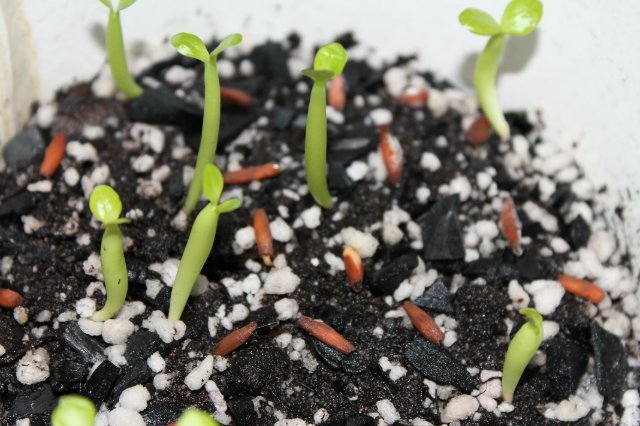

Most adenium seedlings shed the remnants of the seed coat on their own; if this does not happen, the flower can be helped, but only very carefully
Seedlings, unlike adult plants, grow quickly. Young adeniums are picked when they acquire a second or third pair of true leaves. But if circumstances force you to do it earlier - it's okay! The seedling has every chance to take root. Plant your adeniums in separate small pots or in one wide container, always with good drainage!
Video: the first pick of adenium seedlings
Growing problems
If the leaves on the tree begin to turn yellow and fall off, then there are serious reasons for this:
- Low room temperature.
- Dry air.
- Drafts.
- Old soil.
- Wrong watering regime.
If the plant has not bloomed in due time, its forces are spent on maintaining a dense crown. Improper dormancy maintenance also causes poor flowering. Spring watering before the buds appear is another negative factor that worsens the condition of the plant.
- Crimson spots on the leaves. The reason is sunburn. They disappear as soon as the tree is rearranged and the foliage is renewed.
- Stopping growth or flowering. The reason lies in the abrupt change in conditions. With proper care, the tree heals.
- Withering of flowers.This happens if the temperature in the room is high and the plant does not have enough moisture. It is necessary to normalize the temperature regime and add spraying.
- Dark, shriveled stem. Indicates excess moisture. Reduce watering, raise the room temperature, or move the pot to a warmer place.
- Dark soft leaves. The plant has little oxygen and a lot of moisture. Change the soil and rearrange the flower to a different location.
Pruning and shaping adenium
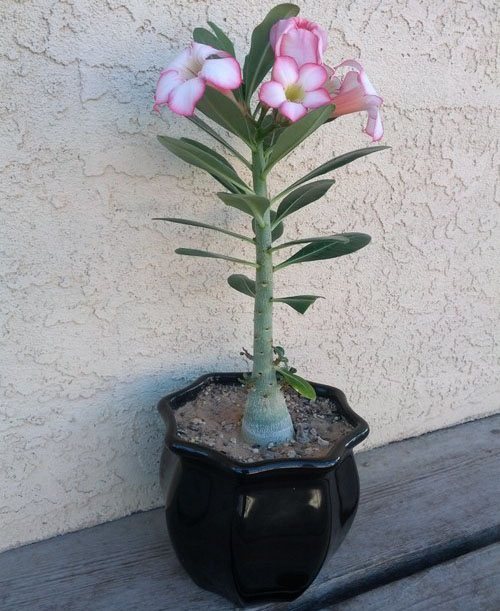

To make the crown dense, branched, flower growers resort to the formation and pruning of adenium.
Often this is simply necessary, since in many plants the apical development is dominant and does not allow other shoots to develop, except for the central one.
Removing the apex activates dormant lateral buds and triggers branching. As a result of such pruning at home on adenium:
- the amount of foliage increases;
- more buds are laid;
- the crown is leveled, voluminous and dense.
Usually, after pruning, more than three buds wake up, and the thicker the cut off the stem, the thicker the growth is formed along the edge of its "hemp".


Also, pruning adenium at home is used to rejuvenate adult plants, some of whose branches noticeably weaken with age. It is carried out with a frequency of two years, shortening the shoots to 5-8 cm.
Temperature and humidity for adenium
Adeniums can be called one of the most "heat-resistant" indoor plants. A comfortable temperature for them is 30–35 ° C. A decrease by 3-5 units does not cause discomfort, but prolonged cooling of the air to 18–20 ° C makes the plant slow down its growth, abandon flowering and start preparing for the winter dormant period.
Signs of depression are also noticeable in an overly warm room. The temperature of +38 ° C when caring for adenium at home is often critical if the humidity in the room is not high enough. Moisture helps the flower withstand heat, but in cold weather, on the contrary, it causes problems.
The minimum allowable temperature for keeping adenium in the room is +10 ° C. If the air continues to cool, the risk of damage to the measles system and its death from decay increases significantly.
Adeniums are characterized by pronounced periods of hibernation or dormancy, when the plant:
- partially or completely sheds leaves;
- stops growing;
- does not form new buds.
A kind of sign for a flower is:
- decrease in the duration of daylight hours;
- cooling down to 16–20 ° C.
Hibernation helps the plant to recover and create a reserve for future flowering. Therefore, for all its time for adenium, they maintain a temperature of about 12-16 ° C and radically reduce watering. It must be remembered that plants cannot stand even light frosts. As in the photo, when caring for adenium at home, you can do without spraying and special measures to increase air humidity.
Where does the plant come from?
Adenium, or "desert rose", is a succulent. It grows wild in the Arabian Peninsula, in African rainforests, in the tropics of Southeast Asia. The conditions of its growth left an imprint on the appearance.
Where infrequent showers are regularly replaced by prolonged droughts, plants are forced to adapt to unfavorable conditions. Wild adenium stores moisture in a thick, fleshy stem called the caudex. Its leaves, hard and glossy (or slightly pubescent), evaporate moisture minimally.


Adult adenium in its natural habitat
Photo
Further you can see in the photo:
What is the desert rose flower?
The desert rose also has a more scientific name - adenium. According to the botanical description, the culture belongs to succulents with a lignified trunk, therefore it normally tolerates a lack of moisture. In natural conditions, a desert rose can reach two meters in height.Naturally, at home, these plants are much lower (Figure 1).
Note: Even with proper care and adherence to all the recommendations for growing, at home, the height of adenium rarely exceeds 50-60 cm, and the plant very slowly grows green mass.
In terms of appearance, the desert rose is a very unusual and beautiful succulent. The trunk is covered with numerous branches on which the leaves are located, rounded at the top. In most cases, the leaf plates are colored emerald, but there are varieties with red-black or yellow-white foliage.


Figure 1. Adenium is a very exotic houseplant
When adenium blooms, it becomes clear why flower growers appreciate it so much. The variety of colors is huge: there are both bright red and pale pink and even lemon and red-black inflorescences. Attractive appearance combined with unpretentiousness explains why this culture is so often used for home decoration.
Adenium transplant
The root system of adenium develops very quickly and loves a large enough space. If the plant is young, I replant it more often, sometimes even twice a year. The material of the pot does not matter, the shape is much more important.
For planting adenium, I use shallow, wide round pots with lots of drainage holes. For small plants, the pot can be taken deeper.
The color of the container also matters. Since your adenium will constantly be in the sun, do not choose dark pots - they get very hot, which is not at all good for the roots.
At the beginning of the growing season, and it falls in the spring, I carry out a planned transplant of adenium, so that by the fall the substrate is completely mastered by the roots. To avoid decay after transplanting, I do not water for at least 2-3 days.
Flower photo
Look at the photo of the "Desert Rose" flower:
Reproduction methods
Desert rose can be grown and propagated in several ways:
- Seeds. A prerequisite is the availability of fresh seeds.
- Cuttings. Using a slice.
- Vaccination. Using the circular notch method.
- Layers. With the help of the stock.
For reproduction, the following conditions are required:
- Comfortable temperature (+ 25 ... 30 ° С).
- Correct lighting (south or east side in the house).
- Twelve hour daylight hours.
- Light soil that provides oxygen access, good drainage layer.
- Dosed watering.
Seeds
The optimal time for sowing is late winter and early spring. The temperature must be above 25 ° C.
Instructions:
- Seeds should be filled with Epin's solution.
- Wait six hours.
- Then put them in a mixture of sand and vermiculite.
- The seeds should be spread out at a distance of 3 cm.
- Cover them with a 5-10 cm thick substrate.
- After seven days, the first shoots can be observed.
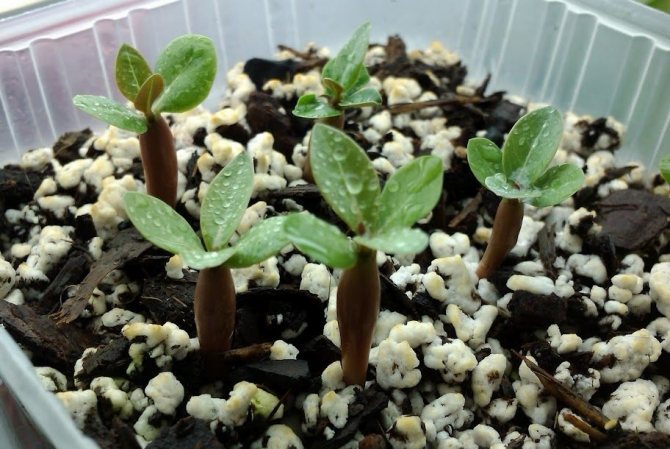

Apical cuttings
In the spring and summer seasons, the plant can be propagated by apical cuttings. Winter is not the right time for the procedure. The length of the cutting should be 10-15 cm. The cut edge is treated with charcoal, and the cutting itself is dried. With the correct humidity (75-80%), temperature + 25 ... 30 ° C, sufficient lighting and high-quality soil, the plant will take root within a month.
Air layering
This is a method that works for both young and adult plants. The procedure should be carried out with the onset of heat.
Recent Entries
Gardener's lunar calendar for 2020: we do it right 3 reasons, make a reservoir in the country: we plan a new season Note for gardeners: 7 useful things to save energy
Step-by-step instruction:
- Choose a 20 cm shoot.
- Make a round cut on it.
- Dry.
- Treat with root stimulant.
- Wrap the incision with sphagnum moss.
- Wrap up with a dark film that does not allow light to pass through.
- Moss the moss regularly.
- After 14-20 days, roots will appear, and the plant can be planted in the ground.
The method has a slight disadvantage: the trunk will not be as thick as that of a fat adenium.
By vaccination
There are two effective ways to propagate a desert rose by grafting:
- Flat. It is less traumatic. The place of the stock on the parent tree is not injured, the cutting itself has only one cut, through which it fits snugly to the desired place. The branch should be taken of a larger or equal diameter than the scion itself.
- V-shaped. From the branch intended for the rootstock, the apical part should be removed. The resulting stump is split and a prepared stalk with symmetrically cut edges on both sides is inserted into the resulting gap.
The vaccination site must be fastened with a cloth bandage or adhesive plaster. After a successful procedure, the auxiliary material is removed, trying not to disturb the junction until complete fusion. Flowering begins within a few months.
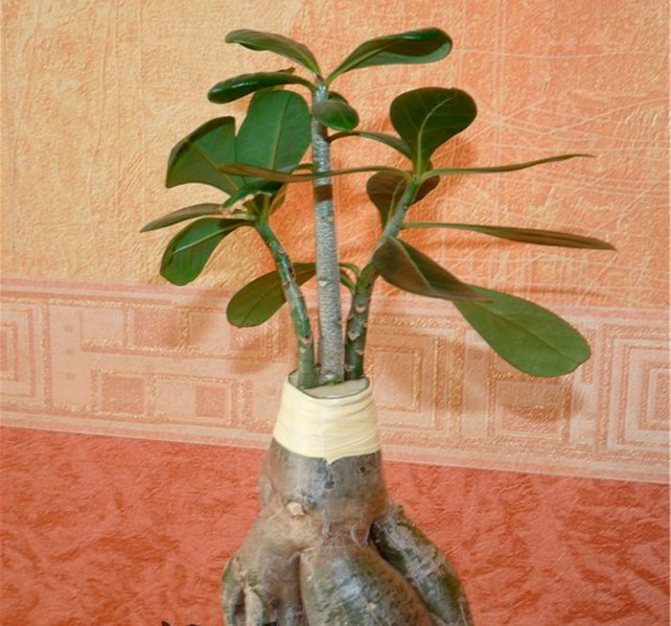

Flat grafting


Flat grafting


V-shaped grafting
Growing method
Experts indicate the following breeding methods:
You can buy Adenium seeds at many flower shops or online. Since the germination period of seeds is no more than 8 months, you need to carefully look at the time for collecting seeds on the package. It should be added that the color of the desert rose flowers may not coincide with that indicated on the package. Of course, bright red ones will not grow from pink buds with a white center, however, they will definitely differ by a couple of tones. The reason is that pollination of flowers occurs with the help of stamens of other plants and this does not allow completely preserving the purity of a particular species.
To grow desert roses from seeds, you need the following actions:
- prepare the soil. The composition of the mixture: agroperlite (volcanic rock with particles of 2–4 mm) or agrovermiculite (also mountain mica, the particles of which are slightly larger from 2 to 9 mm), peat. You can sow seeds into a ready-made substrate for succulents or cacti, or a mixture of perlite and vermiculite. The soil must be moistened with water or a complex fertilizer must be added to it, if planting occurs without the use of peat, only in a mixture of perlite.
- Before sowing, the seeds should be placed in a damp cloth for 2-3 hours. Growth stimulants can be added.
- Seeds laid out on the prepared soil do not need to be sprinkled, otherwise decay of the planting material may occur.
- The containers must be covered with foil and left in a warm place. The temperature should be at least 30 degrees Celsius. The most favorable time for planting adenium is from May to September, during this period the germination rate reaches 80%.
- With further care, you need to make sure that the soil is not wet. The greenhouse should be regularly ventilated. Do not leave seedlings in direct sunlight until the first leaves are formed. After the appearance of four leaves, the plant can be transplanted into open ground.
The method of seedling by cuttings is much more complicated, since the inner part of the plant will be exposed when cut and, due to high humidity, will be susceptible to infection by microorganisms and decay. Experts recommend observing the following conditions before starting breeding work:
- Make sure the plant is actively growing.
- The temperature in the room where the cuttings will be located will be kept around the clock between 25 degrees at night and 30 degrees during the day.
After that, you need to start the direct process.
Soil for rose cuttings should consist of agroperlite, agrovermiculite and peat, observing the ratio of 2: 2: 6, it is better to moisten it with water without using fertilizers.
Cut a stalk 8–12 cm long from the plant, choosing with a thin bark. You can use a clerical knife, this will least damage the plant. You do not need to remove the leaves, they will help the roots to form. The prepared stalk is left warm for 2 hours, but without the sun. Plant the seedlings to a depth of 4 cm, and cover the container with foil or glass, if possible.
The greenhouse needs to be ventilated and watered so that the soil is slightly moist, but not wet.
If the reproduction process went right, then after 3-9 weeks new leaves will appear.
And the next way is reproduction by aerial roots... It is necessary to cut off the bark from the adenium branch in the shape of a ring 7-13 mm wide and let it dry for 15-20 minutes. Cut a square with a side of 15 cm out of polyethylene and wrap a branch and tie it with a thin elastic band, for example, for tying money. Lay the moss around the cut, moisten with water. The polyethylene skirt now needs to be tied up above the cut.
About Once a week, moss can be moistened with a syringewithout removing the polyethylene. At least once every 7 days, you need to check the state of the cut, it is important to prevent the plant from rotting.
If you notice decay, it is best to immediately remove the damaged tissue before a healthy part appears. If the formation of a new bark has occurred on the cut, then the procedure can be repeatedto try growing aerial roots again.
When 4-6 roots have appeared, it is recommended to cut off the upper part. Then the cuts are treated with charcoal and the new sprout is also allowed to dry out.
Transplant the plant into a new pot.
The most common types
Until now, they argue about how many types of adenium exist, and the range in numbers is from 7 to 50. Descriptions of the most famous varieties are given below.
Obesum or obese, the most common not only in nature, but also among gardeners and indoor plant lovers. The size of an adult plant is on average up to a meter, however, there are also tall specimens, up to 3 meters high. It is chosen because this variety can bloom at the age of one and a half years. Often sheds leaves in winter.
Somali - rather tall representatives of the desert, individual plants can reach 5 meters. Therefore, up to two years, it practically does not develop lateral stems, but later it actively branches and its shape is very close to a cone.
Arab - pronounced squat caudex and several trunks, the tops of which are crowned with glossy oblong leaves. They have medium flowers, growers recommend growing this species from seeds.
Socotransky - this variety adapts to the soil and environment. May look like an ordinary tree, with an extraordinary ratio of height to trunk diameter. It has a short period of intense growth and flowering, so it is not often specially grown.
Oleifolium - this variety is represented by small squat plants. It also differs from others in that it grows very slowly. Leaves, collected in a bunch at the top, are narrow and long. Caudex seems to be blurring on the ground. The plant is valuable for its juice; it is used to make preparations that are an antidote to scorpion and snake bites.
Boehmianum - this species has the largest leaves of the entire family. As a rule, they look like a bush, caudex can be 55-60 mm in diameter. Moreover, it is the most poisonous desert rose. The substances contained in its juice are capable of causing death. It is he who is used by the tribes of Africa for the manufacture of poisonous arrows.
Swazicum - is a low shrub, about 45-50 cm tall. It goes well with field grasses in the garden. It is very popular among gardeners due to its unpretentiousness and compactness. In its natural environment, the growing season is short. Many evergreen and long-flowering hybrids have been bred from this variety.
Multiflorum - among the most abundant desert roses. Along the entire height of the trunk, it has approximately the same thickness and there is no thickening at the roots. During the year, the flowering period is about 3 months, begins to bloom 4 years after planting. In winter, it prefers dry and cool air.
Therapeutic effect
The healing properties of the "gypsum" stone coincide with the official medical ones:
- Help bones quickly, properly heal after a fracture.
- Heal tuberculosis of the spine. A plaster bed is made for the patient, which should accelerate recovery.
- Powdered gypsum helps with excessive sweating (hyperhidrosis).
Since the days of Cleopatra, beauticians have been using an aqueous mixture of plaster powder and olive oil as a tonic mask for the face.


Tunisian stone
Why do not roses grow in all deserts?
In the Sahara Desert, stone roses can not be found everywhere. The explanation for this is quite laconic and simple. It can be described in the process of forming roses:
- when precipitation appears in the desert, which are quite rare here, they fall on the surface of the sand and are immediately absorbed;
- gypsum, which is found in large quantities in sand, acquires a hard texture upon contact with water;
- the water evaporates quickly, but only after the hyp heats up and turns into crystals, and then into desert roses.
Therefore, desert roses can only appear where there is a large amount of gypsum in the sand.
What do the roses in the African desert symbolize?
Roses of the Sahara desert are perceived by the inhabitants of Africa in a completely different way from us.
They sincerely believe that these roses are the result of the deadly love of men who go to the deserts in search of a cure for their loved ones.
When they cry, moisture appears and stone roses grow from it, and this happens only after the death of the beloved girls and boys.
There is also a tradition in which residents of northern African countries specifically look for stone roses in order to present one of them to a bride who wants to get married.
On the day of the wedding, the bride's parents give her a stone flower, which symbolizes love and care, a warm family hearth and many bright emotions from living together with her husband.
The Sahara Desert is rich in such gifts, which in fact carry all kinds of symbolism for local tribes and even residents of large cities.
In recent years, African desert roses have been imported overseas, although this is prohibited.
For example, in America, a stone rose from the desert for Valentine's Day is a real highlight. It symbolizes unfading love that will live forever.
Living roses in the desert
There are also real roses in the deserts of Africa. More precisely, they do not look like roses at all, but for some reason they are called that way on this continent.
The official name is adenium. The flower looks like a house plant, it can grow at home, on the windowsill. By itself, it is found in the wild, in Central and South Africa.
Poisonous and adenium, they can neither be applied to wounds, nor, even more so, eat. Therefore, people who want to have such a plant at home should remember that it should not be available to children and animals.
In Africa, adenum is quite rare, and it looks somewhat meager.
The height of a living rose from an empty one is about a meter. The flowers are always pink, but the foliage and stems are somewhat unhealthy. However, this is normal for a desert area.
Such is the fact that many flowers are used here for rituals.
Adenum is no exception, and sometimes tribal representatives go to the desert in search of this plant.
The unusual appearance of adenium and the comparisons addressed to its flowers with a rose, lily or a star are the reasons for the increased interest in the plant from the African deserts. At the same time, adeniums, for which home care is not at all complicated, are very unpretentious.
A little knowledge, diligence, attention, and the pet will respond with lush flowering. And the unlimited possibilities of cutting and shaping allow you to grow a truly unique specimen.
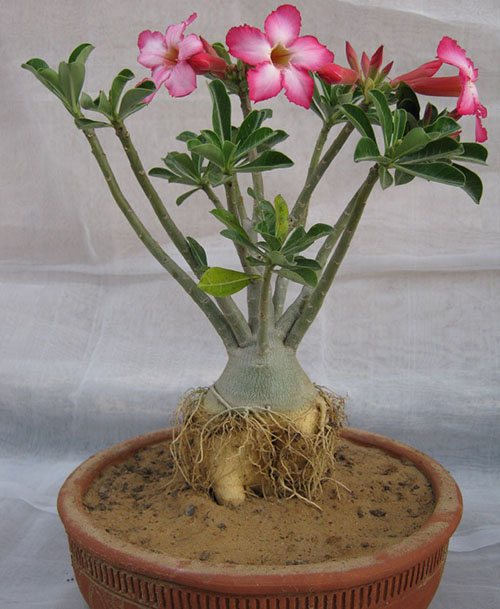

Adeniums have a very recognizable appearance. Thickened intramural stem, a small rosette of dense leaves crowning the apex and large flowers of all shades from white to deep purple.
Plants, which in nature are not spoiled by semi-desert conditions, adapt perfectly in the house, bloom and even allow experiments on themselves. They result in whimsical adeniums shaped like octopuses, mangrove jungle trees or abstract green sculptures.
The secret of successful home care for adenium is simple and consists in ensuring maximum sun, loose soil, regular but moderate watering.

